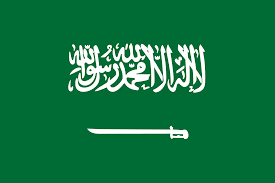
Saudi Arabia
.
.

Trackchasing Country #82
Greetings from places on the way to and from Diriyah, Saudi Arabia. Click on the links below to read about the “story” and see the photos and videos from this trip to a place very few Americans have ever visited, Saudi Arabia, home to my trackchasing country #82.
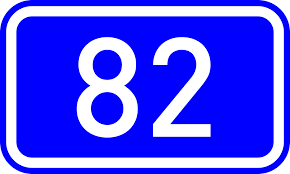
Monday, December 10, 2018
I’m off to Saudi Arabia in search of seeing racing in my 82nd different country. Growing up as a boy in the small Midwestern town of East Peoria, Illinois I couldn’t have told you a single thing about Saudi Arabia. East Peoria was about as closed of a society as Saudi Arabia is reported to be.
Would I ever have imagined visiting a country so far away in so many ways? No, I would not have ever imagined doing such a thing. What does that tell me? First, it’s virtually impossible to predict the future. It’s even more difficult to predict the future if you don’t have a vivid imagination. It is pretty easy in life to simply say, “I don’t think I’ll try that”. However, from personal experiences I say, “the more things I try the more interesting life I’m likely to have.”
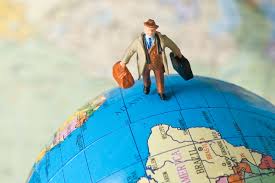
I have several countries sitting in the “on deck circle“ just waiting for me to visit. It seems they all want to be trackchasing country #83. My hobby of trackchasing is really good for getting me out of the house and around the world.
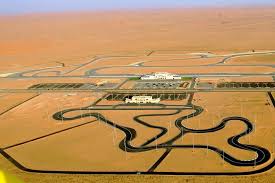
As far as I know Saudi Arabia had only one permanent auto racing track before this Formula E event came about. It’s called the Reem International Circuit. A few years ago I was in active conversations with the track management at Reem. I was trying to find out if and when they raced. I never could get the exact confirmations I was looking for.
It is somewhat difficult in certain “far away”, in more ways than one, countries to find out if they have any auto racing. Of course when I say “auto racing” I’m talking about auto racing that meets the trackchasing rules I follow. Meeting my rules wasn’t exactly the biggest issue with Saudi Arabia.
What WAS the biggest issue? Up until now Saudi Arabia did not issue tourist visas. No visas; no trip. It was as simple as that.
Most the time I get a lot of help from people living in foreign countries, whom I have never met, about race details. They will patiently answer my questions. When I feel confident in their answers I will press the “OK“ button on my computer to buy an airline ticket. You wouldn’t believe how many people I attempt to contact and communicate with before this process can be ultimately completed.
I would have thought that somewhere along the line I would have made a contact with a Saudi Arabia national about racing in his or her country. Maybe I would’ve found someone working in Saudi Arabia from another country. Nope. None of that happened.
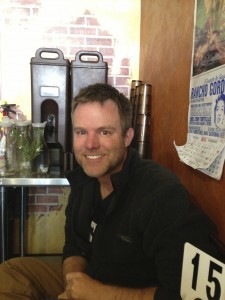
So who turned me on to racing in Saudi Arabia? It was none other than our son J.J. He lives in America and has never been to Saudi Arabia. However, J.J. was the person who gave me the tip that would ultimately transfer into a Saudi Arabian tourist visa.

J.J. sent me a message one day describing something called a “Sharek visa “. Apparently, the government of Saudi Arabia was changing its policy regarding foreign tourism. They were ready to grant tourist visas for people coming to visit Saudi Arabia to see special events. Those events could be music concerts or in this case big name auto racing or both. This was all part of their Saudi Vision 2030 program. What’s that? It is a package of social and economic policies that are designed to free the kingdom from dependence on oil exports and to build a prosperous and sustainable economic future by focusing on country’s strength and policies.
It turned out that the Formula E racing series was going to hold their first ever auto race in Diriyah, Saudi Arabia. Diriyah is a suburb of the largest city in the country, Riyadh. The race would be the first of the 2018/2019 season.
Fans who wanted to see this race could get what was called a Sharek visa. This visa would allow tourists, who bought a ticket to the race, a one-time entry for up to 30 days. This was my chance to visit Saudi Arabia. I couldn’t press the “O.K.” button quick enough on this opportunity.
Yes, I was all over that idea! I immediately went to the Saudi Arabia website where details were offered on the Sharek visa. However, I couldn’t get the website to work with my American phone number.
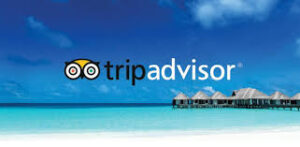
I figured the people who lurk around the tripadvisor forum could help me out. I started a thread asking for an explanation as to what I might be doing wrong. Some people told me they were able to get their special visas using their European phone numbers. I kept trying every day. It took several days but finally my application went through.
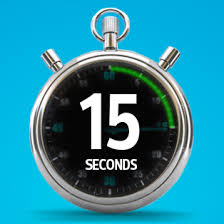
I had to upload a passport photo in order to get the visa. There was no need to spend time and money getting that picture. I simply went to one of the white walls in our house and took a selfie! I cropped it and send it to Saudi Arabia. That “passport photo” along with all of my other passport information got me approved within 15 seconds of the time I sent it! Fifteen seconds. I was headed to Saudi Arabia.
Did you know that if you shop around you can purchase round-trip airfare for about 1,000 bucks to just about anywhere in the world? I knew that. I’ve been to nearly 100 countries in the world using that knowledge.
I had a race date. I had a visa. Now, I had an airline ticket on Lufthansa Airlines. Those were the basics. I would fill in the other details as I went along. It was looking more and more like Saudi Arabia was actually going to be my 82nd different trackchasing country.
Come with me to Saudi Arabia in words and pictures. You can use this “trip” as a trial run. It won’t cost you much. If you like the trip you can go there yourself. However, after your read my Trackchaser Report you may feel as if you’ve actually made the trip and not have to go there in person after all.
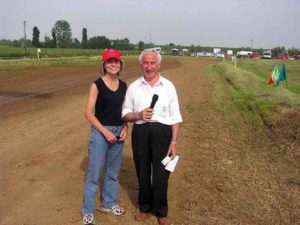
Monday, December 10, 2018
I bid a good morning farewell to Trackchasing‘s First Mother aka wife Carol (pictured above while doing a trackchasing interview in Italy). Then I headed out on this big adventure. Carol will be joining me for our last International trackchasing effort of 2018 a week after I return from this trip.
Today I’ll be flying from Los Angeles to Frankfurt, Germany and then onto Riyadh, Saudi Arabia. The first flight is scheduled to take 11 hours. It’ll be an easy six-hour flight from Germany to Saudi Arabia.
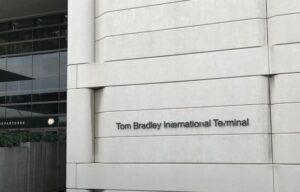
When I arrived at the Tom Bradley International terminal at LAX it took nearly 40 minutes to check into the flight. Lots of people were going to Germany on Lufthansa Airlines today. Luckily, I was able to use the TSA pre-check privileges for this international departure. That sped things up after the check in process took longer than expected.

I’m not a big fan of airline food. It has not bothered me in the least that most airlines have stopped serving their traditional airline meals. That being the case I stopped off at the famous P.F. Chang’s and placed an order for shrimp lo mein as well as shrimp fried rice. Of course, P.F. Chang’s is a member of the Priority Pass Select program. I am too! My total bill was about four dollars plus tip after my $30 credit. Yep. The Chase Visa Sapphire Reserve credit card is almost like having your own personal pot of gold.
Lufthansa is part of the United Airlines Global Alliance frequent flyer program. I’ve never done much business with United. Therefore I don’t have any “juice” with them. Without any pull I wasn’t going to get any favorable seating. I was in row 93 of this Airbus A380 jumbo jet!
I watched movies, did some computer work, slept….and ate shrimp lo mein and shrimp fried rice! I wasn’t impressed with the flight attendant service from Lufthansa. They didn’t seem all that friendly. I felt as if I was being served by a group of robots.
Tuesday, November 11, 2018
I was a little concerned because I had only a one-hour layover in Frankfurt. I’ve had some really long layovers in international airports but too short of a layover could be just as bad as a long one. A one-hour stop was a little risky. If my flight from Los Angeles was delayed by just a little bit I would miss the only flight leaving from Frankfurt to Riyadh, Saudi Arabia today.
Being the last person off the plane, from row 93, delayed me by another 10 minutes. Nevertheless, I did make my flight to Saudi Arabia. I even had time to stop briefly in the airport to listen to and take a short video of three ladies dressed up in angels outfits singing Christmas carols. You don’t see that every day!
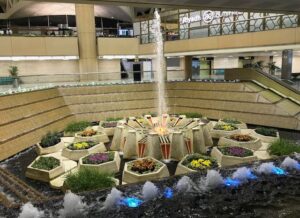
I landed at the Riyadh, King Khalid International Airport at 8 p.m. I was a little worried about just one thing. I had a one-page tourist visa. I had acquired it a couple of months ago. I uploaded my own selfie picture to the visa. I printed the visa on my printer at home. All of this seemed a little to “homemade” for a country that had never shown much enthusiasm toward tourists. I sure hoped my visa would pass muster with the Saudis as I tried to clear border control. Just in case I got “booted” from SA before I ever got in, I took a photo of the airport before I approached border control.
When I approached Saudi border control there were two separate lines. One was for people returning to Saudi Arabia. The other was for folks like me who were making their first ever visit to the country. Each line had about the same amount of people. I noticed that as the women got off the plane they put on their “Saudi Arabia uniforms”, which were essentially long black robes, called “abaya”.They used scarves to cover their hair.
Believe it or not I put on my uniform as well. I had flown more than 17 hours in short pants. I had read that Saudi Arabia wasn’t too keen on people wearing shorts. Before approaching border control I stopped and put on some long pants. When I got to the hotel I took off those long pants and never wore them again on the entire trip.
I’ve noticed and would continue to notice throughout much of the trip that almost all of my interactions with Saudi natives were with men. I didn’t see any women working in the airport. The men seemed to speak quietly. Most didn’t speak English all that well either.

At border control they took fingerprints of all 10 fingers. They took my photograph a couple of times. I guess they wanted to remember me. I breathed a major sigh of relief when my one-page visa got me into Saudi Arabia.
The airport is new, modern and shiny. I went over to the baggage claim and waited for my one checked bag to come tumbling down the baggage claim conveyer belt. I waited and then I waited some more. Soon almost all of the large crowd of people waiting for their bags had disappeared off into the distance. I was still waiting with a couple of other men. Our bags never came.
I rarely check bags anymore. It’s expensive. It’s also a hassle. I’ve got some epic lost airline baggage stories that I won’t take your time with right now. Tonight I filed a claim for my lost bag. I was told my bag would be on the flight coming in tomorrow night. They would deliver that bag to the hotel. That all sounded too good to be true. For some reason I wasn’t 100% confident in that promise.
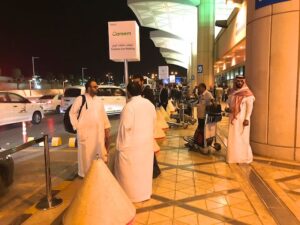
I think one of the things I’m going to like best about my trip to Riyadh is being able to use Uber. I can order an Uber ride and I don’t have to exchange any cash or really even speak to the driver if they are not into English. I’ve used Uber in such faraway places as Croatia. I would be adding Saudi Arabia to my Uber list tonight. I was now outside the airport terminal with lots of new Saudi friends.
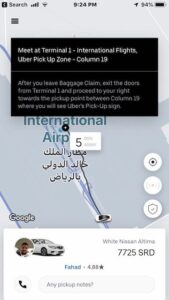
From my iPhone I placed my order for an Uber ride. My driver Fahad drove a Nissan Altima. He carried a 4.88 rating with Uber. Fahad was a big guy. He was also friendly. He told me he had been in Texas going to college for five years until his mother asked him to come back to his home country. Fahad spoke English well. Little did I know at the time that he would be the best English speaking driver I would have from nearly twenty Uber rides.
I would be staying at the Courtyard Riyadh Olaya hotel. This is an upscale Courtyard by Marriott property in downtown Riyadh. I wanted to stay here because I have influence with Marriott as a lifetime Platinum Priority Elitemember. When one travels it pays to have “influence”.
When I arrived at the hotel my bag and I needed to pass through a metal detector. I also had to remove the metal in my pockets. Welcome to the Middle East.
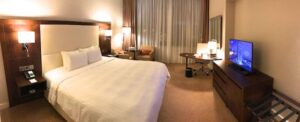
I was minorly disappointed when I was given room 813.The hotel was modern. It looked like it had been built within the last 10 years. My room had a king bed and by most people’s standards would be considered well above average. However, as a platinum member of their frequent stay program I was looking for an upgrade to a suite. I was told they didn’t have any. I would check back tomorrow to see if that situation had changed.
Riyadh, Saudi Arabia is 11 hours ahead of San Clemente, California with their time zone. That meant at 11 o’clock at night in Riyadh it was just 12 noon back home. Nevertheless, after traveling for nearly 24 hours I was ready to get some sleep.
Riyadh is on a similar time zone to most major cities in Europe. Normally on my first night or two into this part of the world I wake up about 3 o’clock in the morning. I did that tonight. I did a little work on my computer and some research for the touring portion of the rest of this trip. Then I went back to sleep for a couple hours. One of the very best things about this trip was that I didn’t have any early morning wake-up calls.
Wednesday, December 12, 2018.
I left home on Monday morning. All of a sudden I was waking up on Wednesday morning. How does that happen? When you fly 16 hours and lose 11 hours in time zone changes you can lose a day pretty quickly. Don’t worry. On the way home I will leave on Monday morning and get home on Monday afternoon.

The weather all week in Saudi Arabia is going to be nice. It’s expected to be clear with a high temperature of about 75° each day and a low temperature of about 60°. There is just one six-hour period with a 20% chance of rain on Saturday morning, race day morning. This forecast was just about what our weather in San Clemente will be like all winter long.
I am normally very pleased with the staff at Marriott hotel properties. They will go out of their way to help you. However, the staff here at the Courtyard Riyadh Olaya is a little short on English. The staff sort of acts as if the personnel manager went down to the local bowling alley and picked about five guys to be the hospitality staff at an upscale hotel. Those would be five guys who don’t speak a lot of English.
I tried to ask the desk clerk about the room upgrade. However, both guys at the desk (there were never any women working anywhere in the hotel that I saw) pleaded English ignorance. They asked for their supervisor to come out to speak with me. He never did. Rather than wait any longer I headed over to the hotel‘s restaurant where breakfast was being served. It was within a few yards of the front desk.

With my Marriott Platinum Elite status I was being given a complimentary breakfast each morning. That was a nice gesture on hotel’s part….especially since they were not giving me a suite! Breakfast was about a $25 U.S. value each day. I’ll be here for six days.
Pork is not allowed in Saudi Arabia. That meant that this morning‘s breakfast sausages would be both chicken and beef. I had something that looked like bacon but was made from beef. The breakfast buffet was acceptable but not truly outstanding. They did have a ton of choices. I guess a “breakfast beggar” can’t a “breakfast chooser”. The restaurant’s decor was bright, and upscale.
I finally did get a chance to talk to the hotel supervisor about an upgrade. He didn’t speak much English either. He told me it wasn’t promising but he would get back to me later in the day. I’m not expecting much.
I looked around my hotel room for the safe. It appeared there wasn’t one. I wasn’t very pleased about that. I’ve got my passport, a bit of cash, my car key and my computer. I don’t want to carry any of that with me all day, each day for a week. I don’t really want to leave it in the room either without a safe.
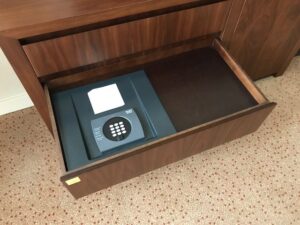
It turned out I was wrong about the room safe. I had to have the bellman show me it was located in one of the clothing drawers. I’ve never seen such a thing but the safe is large and works well. My error. If you do this long enough you’ll see just about everything.
Normally on these trips I have a very robust touring plan. I just haven’t been able to get that going with Saudi Arabia. On tripadvisor nobody was talking about touring options, only religious ones. I guess I shouldn’t be surprised. For the most part up until now Saudi Arabia has not offered tourist visas. If you don’t have tourists you don’t need touring options I guess.

Before I headed out I noticed I had a half-used package of pork rinds in my carry-on bag. That was a definite no-no. As noted pork is not allowed in Saudi Arabia. They consider pork to be “unpure”. Maybe they’ve never tasted pork rinds. I am lucky they didn’t find that at border control. I quickly tossed the contents.
The Internet at the Marriott is one of the best things about the trip so far. I don’t think I’ve ever been to a country where so little English is spoken and understood. Most people speak a couple of words of English but not much more than that. I know that I have never been to a Marriott hotel where English is more limited.
I quickly went on Facebook and started a contest with my Facebook friends to guess where my 82nd trackchasing country will be. First, I gave everyone a list of the countries where I have seen racing. Then I provided a list of all of the countries remaining where I have yet to see any racing. Up to this point I have trackchased in 81 countries. That leaves 115 countries*, of course that’s depending upon how you count world countries, where I have never trackchased.
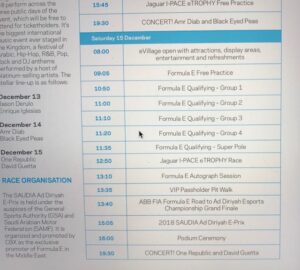
For the first time, I was able to find a complete schedule of activities at the racetrack this weekend. I took a couple of iPhone photographs for future use.
In most countries in the world Saturday and Sunday are considered the weekend. In Saudi Arabia the weekend is Friday and Saturday. Sunday is their Monday! Friday is their Sunday! There will be activity at the racetrack on Thursday, Friday and Saturday. Thursday was primarily for set up, Friday for practice and Saturday for racing.
It looks like there will be two different races on Saturday. The first will be the Jaguar I-PACE eTROPHY race. The the main event of the day will be the 2018 SAUDIA Ad Diriyah E-Prix. This race will happen at 3:05 p.m. The E-Prix is only a 45-minute race!
Following a nice buffet breakfast I headed out to Riyadh to see what I could see for the day. Right off the bat I had an unusual experience. I had ordered an Uber ride. The driver had just pulled up to the front door of the hotel.
I had met a man in the lobby of the hotel. He was a cheerful fellow. He told me he was from Italy. We stuck up a short conversation. With my Uber driver waiting it was time cut our conversation short.
Just as my driver and I were beginning to pull away the man from Italy came running towards the car waving his arms. I lowered my window. He told me he had some “free suit samples” that he wanted to give me. He went on to explain that he has a clothing dealer and he had some extra suits. He didn’t really want to haul them back on the airplane today.
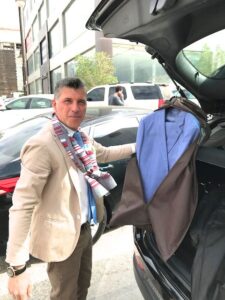
I was a little befuddled by his approach but at the same time curious. I asked my Uber driver to stop for just a moment. The “clothing guy” pulled three suit bags from his large black shiny SUV. It just turned out that all three suits, out of only five or six in the car, were my size. Just lucky?
He went on to tell me these were Armani suits. He showed me a paper saying that each one sold for 2,200 euros.
He had me try on a suit coat. It fit pretty well. The man began to tell me that if I could possibly buy him an iPhone that would be a nice gesture in exchange for the Armani suit. I asked him how much he thought the iPhone he wanted was going to cost. He told me, “$800”. That didn’t work for me. I didn’t need a suit.
We continued to talk and he suggested that I buy some perfume as a gift for his wife in exchange for a suit. I asked how much that would be. He said about $300. I reminded him that I didn’t need a suit but I did end up offering him $100. He couldn’t take that and that pretty much ended our conversation. We parted friends. It was a strange encounter.

I spent some time talking with the Uber driver who brought me to the hotel from the airport. We were talking about “cinemas”, that would be movie theaters. All the way back in 1980 cinemas were banned by the Saudi government. They have only been allowed in Riyadh over the past six months. Riyadh, Saudi Arabia’s largest city has just two of them. Behavior policies are being relaxed somewhat in Saudi Arabia. This is a small piece of evidence of that.
During my international travels I have commonly gone to movie theaters. It’s fun to see a “show“ in a foreign country. In one country, I can’t recall where, everyone stood for the national anthem before the movie began. Folks often do things just a little bit differently than we do in the United States. Saudi Arabia was no exception. That’s why I like to travel.
The hotel staff had told me where a cinema was located. it turned out to be in the Riyadh Park shopping mall.
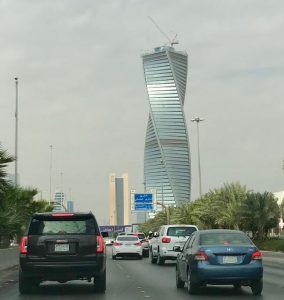
It was a nice weather day. I enjoyed seeing all of the skyscrapers in Riyadh as well as all of the large buildings still under construction. Don’t miss the photos.
Even in poor countries, and Saudi Arabia is not a poor country, shopping malls have been as upscale as any I’ve ever seen in the U.S. That goes to show you that some people have money in every country I visit. Some of the malls, where tropical climates exist, attract customers because the malls have air-conditioning!
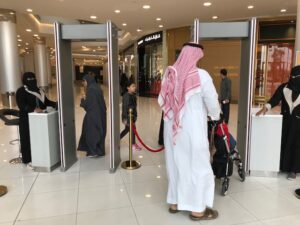
The Vox Cinema is located in the Riyadh Park Mall. Just like at the hotel entrance the mall required people go through a metal detector. I’m sure that security feature is coming to American properties as well.
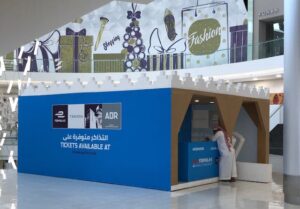
I noticed in the mall that a small kiosk was selling tickets to the Formula E race. That was interesting. I had already purchased my ticket. Buying a ticket to the race was a requirement to get an E-visa for tourists.

I had some time so I took a walk around the mall. I was amazed to see how many upscale stores there were including lots of American brands. They had Victoria Secret’s, P.F. Chang’s and even Krispy Kreme just to name a few!
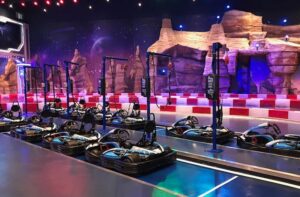
The movie theater itself was located in a huge neon lit arcade. This was not your normal shopping mall arcade. They had bumper cars and even an indoor go kart track. It was impressive.
I wasn’t interested in any specific movie today. I just wanted to experience the Saudi Arabia movie scene limited as it was. I ended up buying a ticket to see the movie “Creed 2”. This was a spinoff of the old Rocky movies starring Sylvester Stallone.
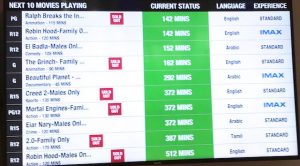
What made my experience unique was that this movie was available for males only. Of all of the countries I’ve ever visited the social differences between males and females in Saudi Arabia is the most significant.
I am virtually the only man that I have seen running around the country in shorts. Granted my shorts do fall slightly below the knee. No one seems to give me much notice so, I’m comfortable with that.
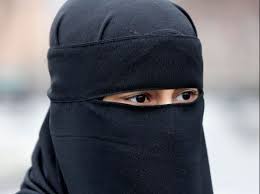
Saudi women normally wear a full face veil, which is called a Niqab. Often times the veil covers everything except their eyes. Foreign women are required to wear an abaya but they don’t have to cover their hair.
I haven’t seen a single woman (Saudi or otherwise) in the country wearing traditional U.S. clothing such as a dress or pants. The weird thing is that the malls I visited had several women’s clothing stores offering western styles. How does that work?
Saudi Arabia has a number of social and cultural rules that must be obeyed by their citizens and in many cases visitors. As mentioned, no pork. No alcohol either. This isn’t like Utah where you can buy booze if you become a “club member”. No alcohol means NO alcohol.
Up until a few months ago women were not allowed to drive. I didn’t look that hard but I didn’t see a single woman driver during my entire stay. No porn either.

Socialization between men and women is limited. Some restaurants in the malls I visited had special lines for men and women. In the famous and dramatically upscale Kingdom Centre mall women and men ate in separate areas. The Victoria Secret store, and lots of other retailers as well, had signs reading, “Families only”. In order to be a citizen in SA a person must be Muslim.
Thursday – December 13, 2018.
I’m finding this international trip possibly my most frustrating of all. Sorry, people just don’t seem to speak much English and/or understand English. I’ve been in some pretty far away countries but Saudi Arabia seems to be the worst in this area of any that I visited.
I get it. They have not had virtually any tourist visitors, English speaking or not….for well, a long time. That fact doesn’t help with the convenience of my trip however.
Today was kind of a lost day. I knew coming here that I hadn’t really been able to discover much of a touring plan. There was very little discussion of tourist activity on tripadvisor or anywhere that I researched.
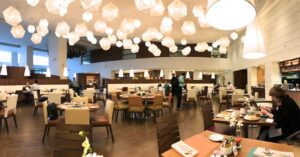
Probably the easiest and most convenient activity of the trip each day have been breakfast. Because of my platinum status at Marriott, breakfast is complementary each morning. I simply walk into the restaurant, give them my room number and then enjoy the buffet in a very modern and upscale atmosphere. Today I had the chef make me an omelet. Again just communicating that idea required me talking to three different people!
Due to the 11-hour time zone difference I find myself waking up in the middle of the night. Last night I stayed up for two or three hours because I couldn’t sleep that well. Then I had breakfast and went back to my room and slept for most of the day!
My one piece of checked luggage still has not arrived. I’ve been calling the airlines several times each day and no one answers the phone. I asked the hotel receptionist if those calls were free. She said they were. When I checked out there was a small charge for each of those calls. No one understands English!
At this point I have no idea if and when I will ever see that bag again. I’m smart enough not to ever check anything in my baggage I can’t afford to lose. I brought two day’s worth of clothing in my carry-on bag just in case something like this happened. That “clothing allowance” runs out today!
When I woke up about 5 p.m. it was time to take some action. As noted I brought two day’s worth of clothing in my carry-on bag. That has been used now. It’s time to go out and buy some clothes so that I can finish my trip especially if my checked bag doesn’t ever show up.
There was a H & M retail clothing store near my hotel. One of the guys at the front desk walked me out of the hotel and pointed me in the right direction to get there. However, at around 5 p.m. tonight they were closed!
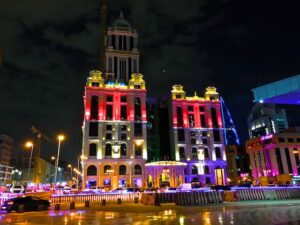
Tonight is Thursday night in Riyadh. Remember Muslims have their weekend on Friday and Saturday not Saturday and Sunday like most other countries. That means that Thursday night is their “Friday night“. People are off of work for the week and looking forward to the weekend. So why was the store closed on a Thursday night?
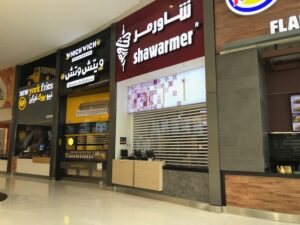
Folks practicing the Muslim religion pray five times a day. Yesterday when I was in the shopping mall and tonight as well the stores close for about 30 minutes during all of the prayer times. That happens during the workday. Tonight I must’ve have just caught the beginning of the closures.
That being the case I decided to keep on walking until I saw some stores that would be re-opening after prayer concluded. All I wanted to do was buy a couple pairs of socks, some underwear and possibly a couple of light weight T-shirts. My needs and wants were simple. It is just situations like this that create “situations” on foreign trips like this. Tonight was no different.
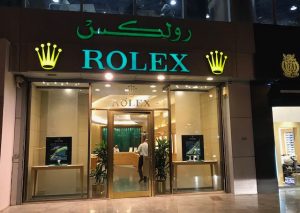
During the early part of my walk I found myself in an area of exclusive stores including Versace, Gucci and Rolex. There weren’t going to be any good buys on underwear in those places!
By the way, I own a gold Rolex presidential model watch. I’ve had it for about 30 years. The retail price on that watch was $17,000 thirty years ago. I don’t wear it any longer. My iPhone replaced the need for a watch. I offered it to my sons at no charge. No takers! It sits in our safe deposit box as we speak.
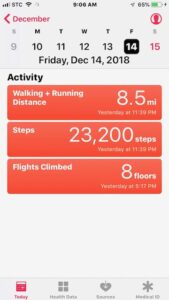
It was dark. Tonight I would end up walking more than 4 miles in search of just a few items. Then the next day I walked 8.5 miles for the entire day. I finally found another shopping mall. International shopping malls, almost always have some really good food courts. Tonight I stopped and ate at one of them. I ordered a serving of Cajun pasta which was excellent.
I had brought along in my carryon bag just one pair of socks. I had now worn those for the third straight day. I thought to myself that life would have been so much easier if I had only put another pair or two into my carry-on bag. Life is full of “if onlies”. I just didn’t expect that I would need them. I stopped in about a half a dozen stores. It was hard enough to communicate the idea that I needed some socks let alone socks that would fit a size 14 foot!

It wasn’t that much easier to buy boxer shorts or a T-shirt. Saudi Arabia is definitely not ready to outfit a person of my size either linguistically or actually. I did get some shoes and underwear.
The retail clerks have been pleasant people. They try to be helpful. It’s just that they don’t speak English and they also don’t seem to be all that prepared for their jobs. Confusion reigns. During my business career these types of people were referred to as “unconsciously incompetent”.
One of my side goals was to make sure that I walked at least 4 miles each day. That was a little more challenging considering I didn’t get up until after 5 p.m. today. However, when I got the notice I had walked four miles I ordered up an Uber driver to take me the rest of the way! By the way, during my entire week-long trip to Saudi Arabia I never saw a single dog. I did see a few stray cats.
In most big cities you can walk on their sidewalks for just about as long and as far as you want. Not in Riyadh. There are no level sidewalks in Riyadh. There are ledges and curbs and elevations so that you can barely walk more than 50 meters before having to go up or down the steps or take a two or three step leap onto the next owner’s property. For being a large city it’s very difficult walking. What else could go wrong or be inconvenient?
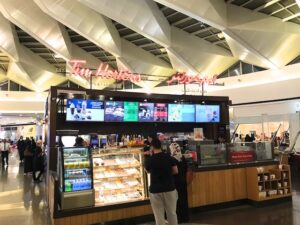
I’m surprised in some ways at how many American brands or at least North American brands I’m seeing in the Saudi malls and stores. Tonight I bought some underwear in an American Eagle store. I saw Tim Horton’s, a Cinnabon. McDonald’s and Burger King in the mall. A Tim Horton’s in Saudi Arabia?
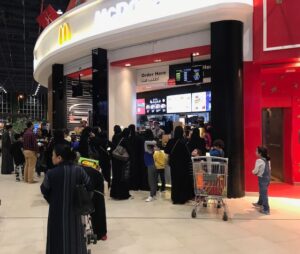
Virtually everyone I run into is wearing Saudi Arabia mandated religious clothing. Every woman follows this whether or not they are natives of Saudi Arabia or not. The foreign women just don’t have to cover their heads where as the Saudi Arabia women do. Women are in black. Men wear white. The only men dressing in a more “western” style are the young workers who have been imported from India or Pakistan or the like.
Tonight when I get back to the hotel I was finally able to get in touch with the airlines. Although it was difficult to communicate in English the person seemed to think they had my bag. But, because they didn’t get the hotel address right the “driver“ was running around with my one checked bag and no known place to deliver it. I don’t know how they could screw that up because I very clearly told them where I was staying. It sounds as if my bag is in Saudi Arabia it’s just not with me.

I washed my one pair of socks in my hotel room sink. This was after I went on YouTube for a “How to wash your socks in a sink” video! I picked up a real good idea on getting the socks to dry quicker than just hanging them up and waiting for them to dry. You can find ANYTHING on YouTube.
Without my checked baggage and with such a difficult time communicating with the local people I’m finding this trip very frustrating. The two local Saudis that have spoken the best English both told me they lived United States for a period of about five years while they studied in college.
I’ve got some pretty eclectic things scheduled for tomorrow. With what I bought at the stores (one t-shirt, four pairs of boxer shorts and a pair of shoes!) I think I’m going to be able to cobble together one outfit that is clean. After that I may be washing more items in the sink!
Friday, December 14, 2018.
The first half of my day did not go very well at all. How often have you ever heard me say that? Not often! Why do my days generally go well? Because I have a plan and I work the plan. If the plan is not going the right way I alter the plan until it does work well. In Saudi Arabia that’s a lot bit more difficult to do.
The one piece of luggage that I checked with Lufthansa Airlines still had not arrived at my hotel. I landed on Tuesday night and this was Friday morning. I didn’t know if I would ever see my luggage again.

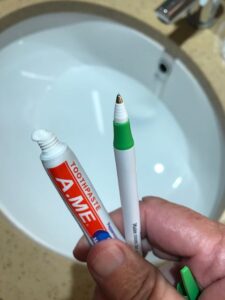
I asked the hotel to give me a “shaving kit”. They did. It included a disposable razor with a small tube of shave cream as well as a toothbrush with a very small tube of toothpaste. Of course, the toothpaste had a safety seal. It took all of my survivalist ingenuity to penetrate the safety seal. I used the hotel’s ball point pen to make things happen. Then a friend from the Maldives suggested I simply use the point inside the cap of the toothpaste to break the seal. Duh! I think I’m just so frustrated I can’t think straight.
I should have known that this was a precursor that my day wasn’t going to go well, at least in the beginning. From the toothpaste incident I went directly to breakfast at the Courtyard Riyadh Olaya hotel. Their breakfast has been one of the highlights of my stay here.

At breakfast I met a couple of members of the Andretti Motorsports racing team. Of course, they are in Saudi Arabia for the Formula E race. Andretti Motorsports has teams in several different series including Formula E, Indy Car and the new ARX Rallycross series. Nice guys. They invited me to give them a call the next time I’m in Indianapolis for a race shop tour.
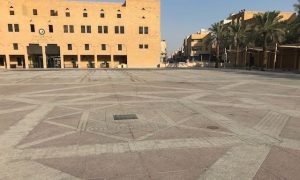
My first “touring” activity of the day would be an Uber ride over to Deera Square. Deera Square has a rather macabre reputation. This is where Saudi Arabia punishes its criminals.
Several states in the America have capital punishment for the most serious of crimes. In the United States capital punishment is normally carried out via an electric chair or lethal injection.
The Saudis carry out their capital punishment solution a little bit differently than we do. Actually, they do it a good deal differently. First of all, they do all of their capital punishment in public. What’s their preferred form of capital punishment? Decapitation by sword. Don’t blame me I’m only the messenger.
I read where is capital punishment is done at Deera Square on Fridays at 9 a.m. I had a morbid curiosity about this. I decided I was going to go out to Deera Square and see what was up.

Strike one! When I got there nothing was happening. I ended up talking with a man from Bangladesh who seemed to be the supervisor of a crew working at the square. He told me that executions are done Sunday through Thursday. Remember, Friday and Saturday are the weekend days in Saudi Arabia, not Saturday and Sunday.
He told me the executions happen at 11 a.m. He and his crew are notified at 5 a.m. if an execution is going to take place so they can get things prepared. “We never get any advanced notice,” he told me. I might just go out there on Sunday to see what I can see. Remember, I didn’t commit the crime but the people who would pay the ultimate price did. When you think about it Saudi Arabia’s form of punishment creates the same result as what we do in America.

Strike two! From there I headed over to the National Museum in Riyadh. This is one of the top five tripadvisor touring recommendations in the city. I had read where they were open each day beginning at 8 a.m. I didn’t fully realize that Friday is Saudi Arabia’s “Sunday”. I was soon informed the National Museum would not be opening up until 4 p.m.

It was a beautiful blue sky sunny day with temperatures in the low 70s. Since my touring options weren’t going that well I decided to do a little power walking. I’ve been having a little problem with my knee but today it felt great. I knocked out a little bit more than 2 miles knowing that I would be doing a lot of walking at the racetrack this afternoon and evening. I correctly predicted that one. At the end of the day my electronic mileage counter showed 8.5 miles.

Strike three! Next I ordered an Uber ride over to the Al Nakheel shopping mall. Believe it or not of all of the touring opportunities in Riyadh, as judged by tripadvisor, the experience at this particular mall was rated number one. When we pulled into the gigantic parking lot what did I see? Almost nothing. The mall was closed until 4 p.m. on Fridays! Maybe that’s why the mall I visited last night was absolutely packed at 10 p.m. on a Thursday night, their Friday night.
I had not done very well trying to search out things that I didn’t control. I needed to get back in control! As my Uber driver began to take me back toward my hotel I had an idea. Just ahead was a McDonald’s. At the very last second I asked my Uber driver to take me to McDonald’s!
He was a little bit surprised. Actually, I was a little bit surprised as well. I have probably ridden Uber more than 100 times. I had never asked any Uber driver to take me to a restaurant. Today, it worked really well.

My driver expertly pulled into the drive-through. I was more than pleased when the McDonald’s employee spoke solid English through the intercom. I ordered a sausage McMuffin meal with a Diet Coke. I offered to pay for my driver but he declined.
By the way my research tells me that a majority of the labor in all kinds of jobs is done by foreign workers in Saudi Arabia. It is just those workers that seem to speak better English than the Saudi nationals.
The service at McDonald’s seemed to be just as it would have been in Toledo, Ohio or anywhere else. I munched on my meal and had it completed by the time we got to the hotel. My driver wouldn’t even allow me to take out the trash. He would handle that.
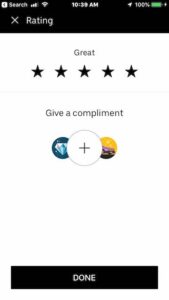
In the United States when an Uber ride has been completed and the driver has pulled away the passenger has the option to leave a tip for the driver via the Uber smart phone app. They don’t have tips in Saudi Arabia for Uber drivers. Passengers are asked to leave them a compliment if they like. They even have a series of five or so general topic compliments. The passenger can personalize that compliment by writing a short note. This was the first time I had ever seen this option.
When I arrived back in my hotel I called the lost and found department back at the airport. I’ve been calling them every day. Most of the time no one answers. Today I got a live person and was told that my luggage had been delivered to the hotel last night shortly after midnight! Really?
I called the hotel receptionist and she checked with the front desk. Nope. My luggage had not arrived. I went down to the front desk. They again confirmed there was no luggage delivered for me.
As a sales manager for Procter & Gamble I used to send display and sample materials to hotels all the time. It seemed that more often than not when I checked with the hotel they told me they hadn’t received anything and, of course they had.
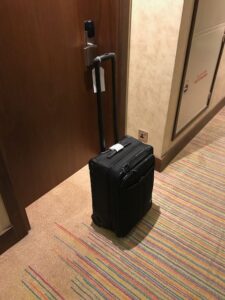
Running off my previous experiences with the hotels not understanding what the left-hand or right-hand might be doing I asked that we check their stored luggage room. What did I find? My one long-lost piece of luggage! No, the staff at this Courtyard by Marriott is not on top of their game. The two or three guys working the front desk are on their cell phones more than they are in front of the customers. They don’t speak or understand English very well. Although the physical property of the Marriott is as nice or nicer than any I’ve seen the staff is not up to the task.
I would never like to paint everyone with one brush. I was doing some research on Saudi Arabia and their culture. The article told me that most Saudis were sheepherders and not farmers. The implication was that a farmer would be accustomed to hard direct manual labor. The sheepherder would more likely sit on his butt and watch the flock.
The article went on to say that almost all of the labor in Saudi Arabia is done by foreign workers. It said that the unemployment rate for Saudi‘s is in the 30-40% range. Most of the jobs the Saudis do are in government positions. I’m seeing that theory at work at my hotel and actually in many of the jobs I’ve observed on this trip.
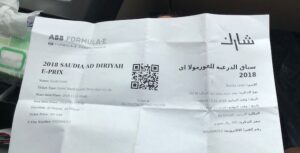
It was now early afternoon and time to head out to the racetrack. They weren’t having any formal racing today. They would only be practicing. However, the ticket (above) I bought was good for admission to the track for all three days. I figured I might as well do a “test run“ to make sure everything would go smoothly for tomorrow when they are racing. That would prove to be a very good idea.
My research told me it might be a good idea to get some transportation from one of the track’s satellite shuttlebus locations. At any one of those places I could then take the bus into the racetrack where parking was limited.
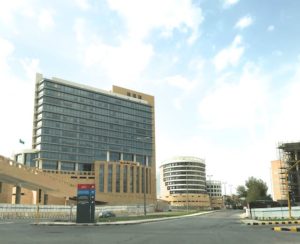
I decided to take an Uber ride from my hotel to King Saud University. They had shuttle buses running from there. Wow! King Saud University was massive. It had all kinds of new construction as well as under construction huge buildings. Actually the place looked like a small city. The place was absolutely gigantic.
It took my Uber driver some time to find a location in this massive complex where the shuttle buses were located. I made a mental note that I might want to try one of the other pick up locations tomorrow!
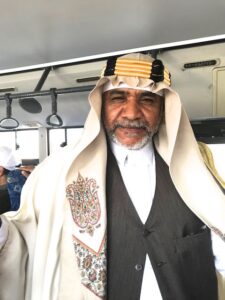
The shuttle buses were free. When I was on the bus an older man (probably younger than me!) dressed in traditional Saudi Arabian attire was walking up and down the aisles. He was handing out candy to not only the kids but everyone on the bus. When he got to me he immediately recognized that I wasn’t from around here. I get that a lot. The man engaged me in some conversation and friendly banter. He asked if I wanted any “stick candy”. He meant in my lingo, did I want a candy sucker?
The young Saudi Arabians seated near me helped out with English explanations when needed. There were lots of nice people on the bus. Everyone I’ve met in Saudi Arabia has been great from a personal point of view. I just had a little bit of a difficulty communicating with most of them and being understood.
I had printed out my race ticket in advance back in San Clemente. Now I was hoping there would be no glitches and I wouldn’t be turned away if I overlooked some minor detail. My printed ticket worked just fine. I was in the complex called the Ad Diriyah E-Prix racetrack.
I could hear the Jaguar I-PACE electric cars going around the track. O.K., I couldn’t hear much of their engine noise but I could hear the tires squealing. I wanted to find my seating location and check things out. That was much easier said than done.
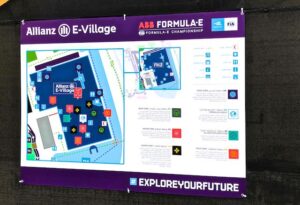
The general facility has what they call an “E-Village”. The track provided a nice brochure describing what was available in the E-Village. Food and drink concessions, a huge concert stage and viewing area as well as a mosque were included in the E-Village set-up. They had a cultural village, a time travel tunnel and a family zone. It was all done very nicely.
One of the staff at the track today seem to think that I was in grandstand 2. I thought that as well. There were five numbered grandstands for the unwashed. The unwashed? Yes, the fans who had purchased the basic ticket with no additional hospitality.
This would have been a great event to have had an upgraded ticket. However, the cost of a top of the line ticket was around $1,000 U.S. That was too pricey for this retiree. Don’t feel sorry for me. I’ve been the beneficiary of “corporate generosity” during my lifetime. Others have paid for my admission to the Super Bowl, the Indy 500 and three World Series. I’ve done all right. All of those events came with massive hospitality.
By the way I NEVER begrudge the success of others as so many of my fellow trackchasing competitors have done over the years. Shame on them! There’s one guy who feels “left out” at America’s private country club tracks. Accept it. If you were more successful you could get in one of those places! I feel if someone has achieved more than me…good on them. If someone can afford a $1,000 race and hospitality ticket I hope they have a great time. Maybe some day, if I work hard and make the right connections, I might have the same opportunities. In the meantime, I’ll enjoy what a $100 U.S. ticket has to offer.
Grandstand 2 was a LONG walk from the entrance of the entire facility to the grandstand. Did I say it was a LONG walk? I’m going to say the walk was well over a mile. I made the trek over there only to find out that my ticket wasn’t good for grandstand 2 but grandstand 4! I told you I have had a great deal of difficulty communicating and being understood here.
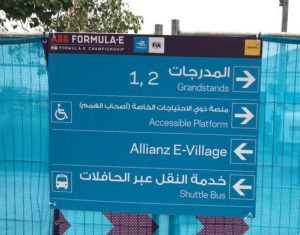
Where was grandstand 4 compared to grandstand 2? It was about twice as far away as I had already walked! Since there were only a handful of people in the grandstands I asked the usher if I could simply sit in grandstand 2 for the last few minutes of on-track activity. No, I could not. He was nice but firm. I hate it when people are sticklers for goofy rules.
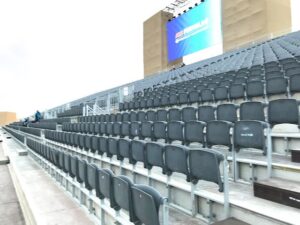
By the time I made the long walk over to grandstand 4 practice was finished but I had easily met my four-mile daily walking goal! Nevertheless, I just wanted to experience the ambience of sitting in the grandstand. I noticed a couple of fellows sitting in the very top row of the grandstand 4. I made the walk all the way up there and offered up an opening comment by saying, “These are the best seats at the track are they?
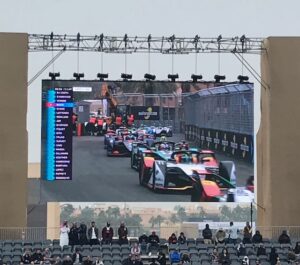
They smiled and soon we were into a full-fledged conversation. These guys were from Kent, England. They were in charge of the massive video screens at the facility today. They had shipped in about 20 of these large screens, which are used all over England.
It was fun talking to them. Their company just got the contract to take these screens all over the world at events like Formula E and more. That’s got to be a fantastic travel experience for these young guys. They were great to talk to. The fellows were also pretty impressed with my trackchasing hobby as most people seem to be.
The Ad Diriyah track is a purpose built road course for this event. It’s 2.495 kilometers or a 1.5-miles long. From my viewing position I was only going to be able to see racing for about a quarter-mile of the track. The racing surface was extremely narrow. Even though it is a freestanding permanent road course for some reason the constructors thought it was a good idea to make the entire track only a couple of car widths wide. It’s going to be difficult to pass on this baby.
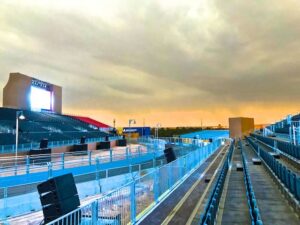
As the sun began to set I bid my new English friends farewell. At that point I made my favorite photo of the entire trip. I was seeing the track just in the right light. Then I headed over to the E-Village area. There I continued my entertainment experience for the next four or five hours.
There wasn’t all that much going on. I was surprised they had almost no souvenirs, especially souvenirs with the words “Saudi Arabia” written on them. I would have loved something like that. They had a handful of shirts and a few hats but nothing that met my souvenir requirements for international track visits.
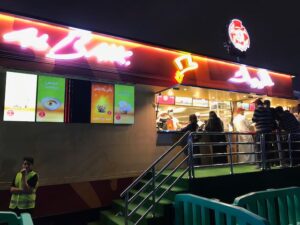
I went looking for what might be a good Saudi Arabia at the track supper. I decided on a fast food type food trailer. They were serving up chicken fingers, French fries and lots of garlic sauce. Their food was actually excellent.
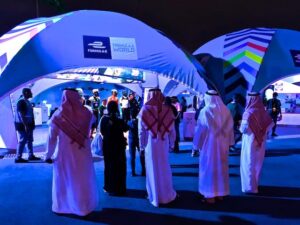
People were sitting at a series of picnic tables enjoying their meal. All of the tables were full except for one. At that table two Saudis in their traditional dress. They were enjoying their dinner. There was room for me and I asked if I might join them. They immediately welcomed to me.
One of them was enjoying a large pizza. As soon as I sat down he pulled out a slice and handed it to me. These were friendly guys. When I got all of my materials out of my food sack I offered them a sample as well. They declined in a polite way. I would end up talking to several Saudis on this evening and they all were as friendly as punch! Friendly as punch? Yep. That’s what I said.
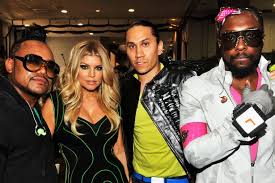
Tonight would be the second night out of three where large and popular musical acts would be performing on a very large state of the art stage. Tonight’s show was being headlined by the world-famous Black-eyed Peas.
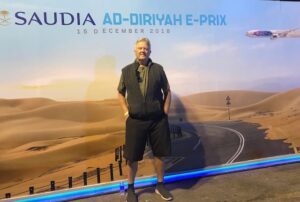
I didn’t have anything else going on and figured I might as well stay and enjoy the show. I had paid for it. I had wandered all over the E-Village. There was something most unique about tonight‘s concert.
This might sound hard to believe. This weekend was the first ever musical concert held in Saudi Arabia in front of a mixed gender audience. Folks, this is 2018. However, I believe what I told you is true.
The first music begin playing at 6 p.m. A DJ was playing some very upbeat recorded music with super strong bass sounds. He continued to implore the crowd to “jump, jump, jump“ and then went with “raise your hands, raise your hands, raise your hands.” This went on for about a half hour. Most of the crowd loved it. I thought it got a little repetitive.
Tonight there would be four major musical performances including the aforementioned DJ’s effort. Between each of the performances there was a 30-60 minute downtime. That got to be a bit much.
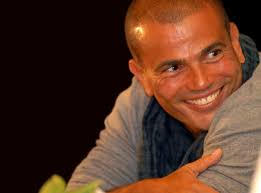
The two top performers were an Egyptian singer named Emr Diab and the Black-eyed Peas. All of the musical performances were done in English with the exception of Mr. Diab’s performance. That seemed a little odd since English was a distant second or third language for most of the Saudis. It almost seemed as if the crowd liked Emr Diab’s performance more so than the more famous Black-eyed Peas.
Although I am not a music aficionado I had certainly heard of the Black-eyed Peas. Emr Diab had never registered on my radar. At the outset of tonight‘s event I couldn’t have told you any of the songs the Peas had done but I had certainly heard of them as a band. That’s not a knock on the Black-eyed Peas. I couldn’t tell you a single hit from the Rolling Stones! I would come to re-learn that one of the Peas’ biggest hits was a song called “Let’s get it started”. They opened with that diddy.
I’ve got to tell you I was a little disappointed in the Black-Eyed Peas. They seemed to be more of a rap group than anything else. They’ve been around for a long time seemingly pre-dating rap music but maybe not. At nearly 11 p.m. I left their show just a little bit early to try to beat the crowd.
I had ridden the shuttle into the track from the King Saud University location. However, since I didn’t have a parked car parked there I could take any shuttle back bus back to any location that I wanted. I chose the Doubletree Hotel. That was quick and easy although once again it was a very very long walk from the E-Village to the shuttle buses. Like I said I finished the day with 8.5 miles of walking.
Once at the Doubletree hotel I quickly commandeered an Uber driver. Given how busy the traffic had been at the track as well as on the local roadways on a Friday night I was surprised at how quickly my Uber driver got there.
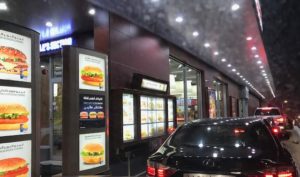
I was feeling the munchies after my at the track chicken fingers had worn off. That being the case I decided to have my driver make a last-minute right turn into a Herfy’s fast food establishment. I had never been to a Herfy’s. They are a Saudi Arabia headquartered fast food chain.
I was surprised at the quality of their offerings. Despite it being so late my will power was down. I ordered a double cheeseburger, French fries and apple pie. It was all delicious and as good as what can be found at McDonald’s and I love McDonald’s.
I didn’t get to bed until nearly 1 a.m. I could sleep in a bit. The first actual race at the track tomorrow will be a preliminary event featuring the Jaguar I-PACE electric cars. That race begins at 12:50 p.m. I hope to be in my seat in grandstand 4 for the start.

The main event for the Formula E cars will begin at 3:05 p.m. These are electric cars as well. They very closely resemble Formula 1 racing machines. Their race will be super short, only 45 minutes long.
This is the fifth season for Formula E racing. Up until this year the electric power was so limited that in the middle of the race the drivers made a pitstop. They didn’t change tires or add gas. They changed cars!
Now with improving electronic battery technology drivers can go 45 minutes on one charge with one car. I’ve never seen a Formula E race. I’m looking forward to it. Good night after a very long day at the Ad Diriyah E-Prix racetrack.
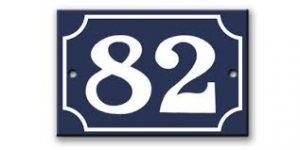
Saturday, December 15, 2018
Today I will be trackchasing in a new country for the very first time. I have only been able to say that 82 times. Did I think I would ever be able to say that about Saudi Arabia? Probably not.
I continue to be amazed at the lack of English understanding in Saudi Arabia. I’m staying at a really upscale Marriott Courtyard hotel. You would think that employees at the Marriott would have a decent command of English. That’s not the case. I’m pretty sure I know why. The country is both insolated and isolated from outside influence. They just don’t have the need to speak much English.

This morning I called the receptionist to find out if they had ice machines. They did not. When was the last time you stayed in a major hotel that didn’t have an ice machine?
I kept asking about ice and ice machines. The hotel receptionist thought I was asking about ice cream. She went on to explain how they had flavors such as chocolate and strawberry. What does a person do when they can’t be understood? They keep repeating what they’ve already said and raising their voice. I just kept saying “ice, ice, ice”. In frustration I asked the receptionist if she understood English! That question can be asked nicely right? Maybe not. Finally, she understood and said that room service would bring me a bucket of ice. OMG.
My Weather Underground weather smart phone app is fantastic. They’ve been forecasting a small amount of rain for this Saturday morning for a week or more. When I looked out my eighth floor window today what did I see? A light rain. I don’t think the rain will be problematic. It is rather amazing how Weather Underground can be so accurate so far out. I’ve seen this with them several times.
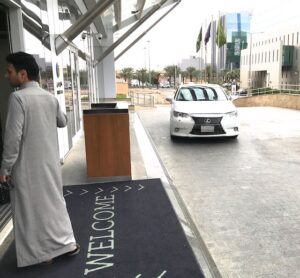
Following breakfast at the hotel I ordered up an Uber ride. I’ve used Uber about 15 times on this trip. This was the first driver with a Lexus though. Uber works very well for me here. The rides are relatively inexpensive, usually only about five or six U.S. dollars. I’m spending less on Uber that I would have spent had I rented a car. Additionally I don’t have to worry about parking or directions. Why didn’t I think of Uber?
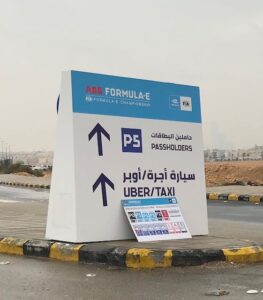
Yesterday I had an Uber driver take me to a drop off point where I could then catch a shuttle bus directly to the racetrack area. Today I figured I would just try to have the Uber driver take me to the racetrack itself. That worked reasonably well although I’m glad someone else was doing the driving since several of the exits were closed along the route. They had a special drop off section for Uber and taxi passengers. That was a very convenient idea.
In order to get a travel visa to Saudi Arabia I had to buy a ticket to the Formula E race. I was happy to do that. The ticket cost me about $100 U.S. The expense for the visa was about $170 U.S.
In reality, spending $100 for the race ticket was a bargain. It gave me admission to the racetrack for three days, Thursday Friday and Saturday. In addition to the on-track activity there were major musical concerts over all three nights. Yes, a hundred bucks for all of that was a bargain.
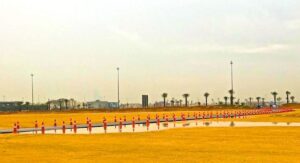
It had rained pretty good during the night until about 9 a.m. this morning. Luckily much of the grounds where pedestrians would be walking were paved with asphalt. I wondered how long they had been creating the site for this event, which is essentially out in the middle of the desert.
My goal was to get in a couple of miles of walking before I headed to the grandstand. Yesterday, I had been seated in grandstand 4. Although I had the same single printed ticket today they put me in grandstand 3. Once I was in an individual grandstand I could sit anywhere I wanted.
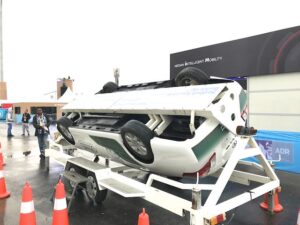
There were a number of commercial displays in the “E-Village”. One of them was promoting the use of seatbelts. They had a special display where a person could get inside a real car, fasten the seat and shoulder belt, and then the car would rotate on a horizontal axis as if it were flipping. With my height my head touched the roof when the car was upside down. Nevertheless, this was a good demonstration of the value of seatbelts. I was able to exit the car unharmed!
Although I wasn’t hungry I knew that I would be hungry before the end of today’s race at about 4 p.m. Food was only served inside the E village. There were no food and drink refreshment areas near any of the grandstands. That seemed like a huge mistake. The grandstands were all a long way from the E-Village and their refreshment stands. The track’s management did have people giving out bottles of Aquafina water for free all around the racetrack.
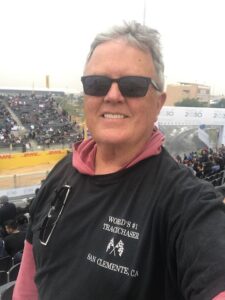
The weather was cool and damp. I was glad I brought my Cornell lightweight hooded sweatshirt. I almost didn’t bring it. With a temperature of 17°C and a wind of 10 miles an hour or so I was glad I had that sweatshirt underneath my “World‘s #1 Trackchaser“ T-shirt.
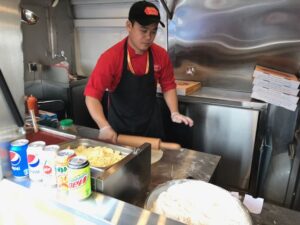
I was able to order a custom made pizza from one of the vendors in the E-Village. It took 12 minutes to make. While that pizza was baking I went off on a 10-minute power walk. I find that whenever I have an extra five or 10 minutes I can add a little walking, which helps me reach my 4-mile daily goal.

I was able to eat about half of my medium-sized pizza in the nearby picnic table area. I took the rest for consumption in the grandstands later in the day.

The walk from the E-Village to grandstand 4 might’ve been about a half of a mile. I’m going to guess that my particular grandstand seated about 1,000 people. Because I was early I was able to garner a top row seat right above one of the aisles giving me lots of legroom. I would stay there for the rest of the day.
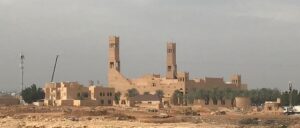
Just behind my grandstand was a huge Saudi mansion. It had to go 20 or 30,000 ft.² or maybe more. It was hard to get a good picture of it with all of the tall retaining walls that surrounded it. I was told by a local that it belonged to the Saudi royal family. In the other direction was another huge mansion type structure. I think it was a mosque. Don’t miss the photos. I would have given anything to see what those places looked like inside.

I was in plenty of time to see the Jaguar I-PACE event. It was this race that actually made the Ad Diriyah E-Prix road course configuration my 2,514thlifetime track. There were only two races today. The Jaguars went off at 12:50 p.m. They started 12 cars. I could see about 15 seconds of their approximate one minute and 40-second lap. When they were not in front of me, which was most of time, I could watch the race on the huge video board just above grandstand 3 where I sat for a brief time yesterday.
Was I disappointed that I could see so little of the racing? Not in the least. You see I learned all about life by playing golf. With golf I learned to manage my expectations. I wasn’t EXPECTING to see much of the race in front of me today. That’s what road course racing is. If you come with the right expectations to whatever you are seeing or doing, you’ll be much less likely to leave disappointed. PLUS…..this trip was not about the race, it was about the chase. Understand?
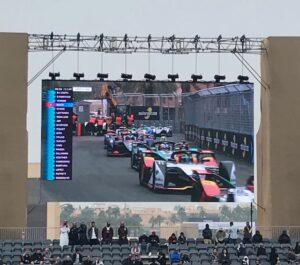
The video boards were great….for the video. However, the audio was not synced with what appeared on the video most of the time today. Two young broadcasters, male and female, walked through the paddock and the E-Village interviewing people. Most of the time while their interviews were being broadcast the on track activity was being featured on the video board. That was a mess.
I don’t know how many people came to the race using the E-visa. From the looks of things most people were local and dressed in traditional Saudi Arabia garb. I wonder how many people used the race ticket to get the E-visa for Saudi tourism and didn’t attend the race itself?
I have been told that fans from the United States made up more of the visa requests that any other country. That probably stands to reason because people from the U.S. are avid travelers. Nevertheless, I didn’t see or hear a single U.S. race fan during the approximate 12 hours I was at the track over two days.

I did meet an interesting man from Greece following the racing on the shuttle bus ride out of the track.. He wasn’t a race fan but he wanted to visit Saudi Arabia. When the opportunity to get an E-visa tourist visa came up he bought the race track ticket so he could get the travel visa.
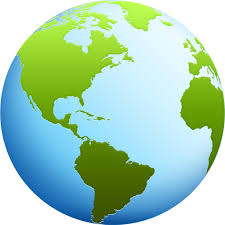
His hobby was somewhat similar to mine. He didn’t chase racetracks; he was chasing countries. He told me that he has now seen 156 out of the 193 U.N. listed countries. He figured that sooner or later he would see them all. He told me about websites, which keep track of these things. I plan to check them out.
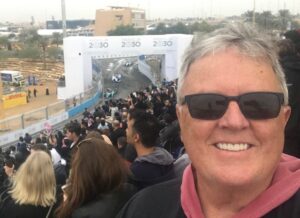
There were 22 starters for the Formula E main event. The race length was 45 minutes plus one lap. Forty-five minutes for a race of this stature might not seem like very much time. However, when you can only see 15 seconds of each lap or about 15% of the entire race 45 minutes is plenty of time.
I know that NASCAR will likely shorten some of their races in the future. I don’t think they’ll ever cut them down to 45 minutes! One of the reasons the Formula E races are so short is because the batteries won’t last much longer than 45 minutes creating the massive power that they do.
For the most part I didn’t notice much difference overall in the sounds from an internal combustion engine and the electric cars. Don’t get me wrong. The sound wasn’t the same. However, the electric engines did send off a little bit of noise. Without the roar of a gas engine fans could really hear the tires squealing. Today I could also hear the track commentator and the fans cheering much more than I ever could at an internal combustion competition. Once they got going I didn’t notice much difference, gas vs. electric, today in the overall experience.
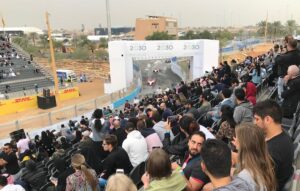
I’m going to guess that well over 90% of the fans in the stands were seeing the very first race in their lives. Saudi Arabia does have a permanent road course, It’s the Reem International Circuit, but they don’t race there all that often.
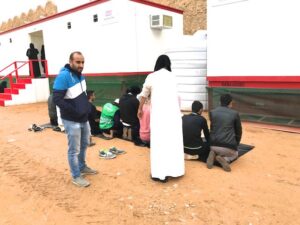
The muslim religion is obviously a very strong part of most Saudi lifestyles. There were men and women prayer rooms at the track today. Muslims pray five times a day starting before sun up. When it’s prayer time all of the shops in the country close. Today when the race was finished I saw several Muslim men laying down plastic garbage bags on the muddy ground. They prayed from there. You won’t see that at Eldora. That’s a pretty strong commitment to your religion. It was also most unusual to hear the Imam calling people to prayer over the nearby mosque’s loud speaker just as the race was about to begin.
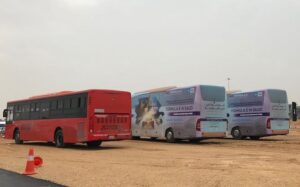
When the races were finished shortly before 5 p.m. I grabbed a shuttle bus and rode it over to the Riyadh Park Mall. I had visited there a few days ago primarily to see a movie. Today’s shuttle buses were huge modern greyhound like buses. My bus today had less than 10 people in it leaving the track.
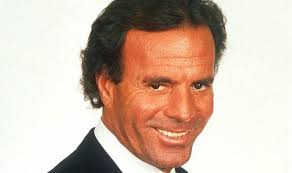
It was sort of odd to see more people entering the racetrack when the races were finished than were leaving. Tonight’s headline concert performer was Julio Iglesias. I think the music was expected to start a little bit more than an hour after the race was finished. In some ways I think the race itself was an oddity to the Saudis. The musical concerts were the real attraction.
It was smart on Formula E’s part as well as the Saudi government to have both the E village and the huge concert set up. On its own I don’t think Formula E could draw a very good crowd. They are a relatively new series. The track just doesn’t offer much in the way of viewing opportunities for the fan. I’d love to see Formula E slinging their machines around Knoxville. Nope, won’t ever happen.
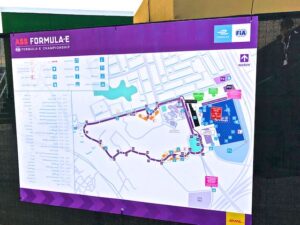
Today’s 21-turn permanent road course was extremely narrow. I would hate to be driving on a two-land road that was as narrow as today’s track. There was very little passing but there was a pass for the lead one time.

Earlier in the week I had met a couple of the guys from Andretti Motorsports. One of those people was J-F Thormann. He is the president of Andretti Motorsports. Congratulations to their team and driver, Antonio Felix da Costa winner of today’s event!
I can’t imagine the amount of money the Saudi government dropped on this race. Building the track, bringing in the teams and all of the other costs must have been beyond substantial.
I’m not exactly sure what they expected to get from that expense. More tourism? More exposure for Saudi Arabia, which has long been a very closed society? Whatever they expected to get in return the cost was heavy.
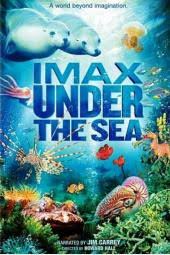
Once I reached the shopping mall I decided to try to catch another movie. The only thing playing was an IMAX 3-D production titled “Under the Sea.” I bought a ticket and then proceeded to sleep through most of the production! Being out in the cool, windy and damp weather was tiring.
I intended to grab something for dinner at the food court following the movie. However, when the cinema was finished it was prayer time in Saudi Arabia. All of the stores were closed in the mall for prayer. I didn’t feel like waiting for them to reopen.
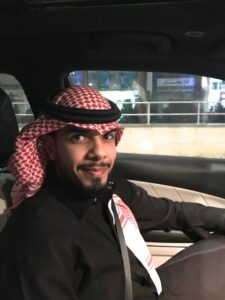
I called up another Uber driver. A young man dressed in traditional Saudi attire showed up. I asked him to take me to a Herfy’s fast food restaurant on the way back to my hotel. However, something got lost in the translation and he simply drove me back to the hotel. No problem. I could stand to miss a meal.
This would be my last full night of sleep in the Marriott Riyadh Olaya hotel. One of the best things about this trip is that I’ve been able to sleep in every day and then come down and have a leisurely quality buffet breakfast. I guess there are some benefits to being retired!
I would say the two highlights of my Marriott visit were the buffet breakfast and the hotel’s Wi-Fi. I have a one GB data plan while in SA that I could use with my phone when I am out and about during the day. That’s not all that much but enough for when I need to use my phone when I’m touring. Then when I got back to the hotel each evening I could go back onto the hotel’s Wi-Fi, which can also be used for my phone. I just can’t make phone calls, inexpensively, when I’m here. This AT&T “passport” plan had worked out very well. Tonight I spent an hour planning future trips and talking to friends via the Internet from all over the world.
Sunday, December 16, 2018
Today is my last full day in Saudi Arabia. I’ve got a 4:10 a.m. flight departure tomorrow on Monday. I’m not exactly looking forward to those two flights, which are scheduled to take a little bit more than 18 hours.
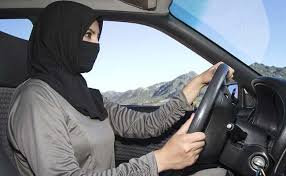
I must say this. Saudi Arabia drivers are a little bit suspect. They have a nasty habit of driving right down the center of two lanes on the freeway. Tailgating and “nudging in” appear to be a national past time for these drivers. So far I haven’t seen a single woman driver even though they were given the right to drive a few months ago.
I have been riding Uber everywhere. It’s very convenient. This “shared ride” opportunity didn’t even exist as little as 10 years ago. What else will happen in the next 10 years that we had never even thought about?
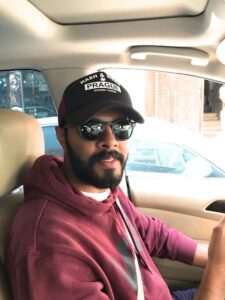
Today my Uber driver spoke English fairly well. Most people speak and understand very little English in Saudi Arabia. I’m sure that comes from the limited amount of tourists that have been able to come here in the past.
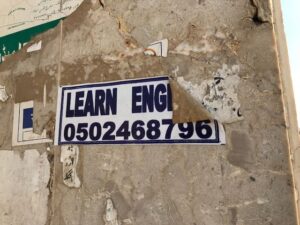
I always engage my Uber drivers, and everyone else for that matter, in as much conversation as I can handle and they can handle. Three of the very best English speakers that I have met on this trip, and I probably met well over 100 people, were all students in the United States. The first fellow went to the University of Texas – San Antonio. The next guy, who worked in an American Eagle store, attended Montana State University. Today’s Uber chauffer attended the university of Arkansas – Little Rock. There was a reason they spoke English as well as they did.
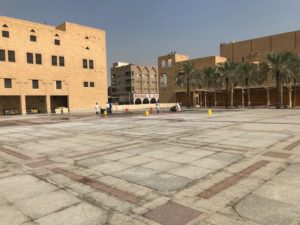
This morning my first stop was a return visit to Deera Square. I must admit I had a fascination with this place. It’s where they punish their criminals. How do they punish them? They decapitate them in front of a public audience. However, just like my visit of a couple of days ago there was nothing happening today. Maybe that was for the best. The punishment is sort of a random act, not necessarily a random act of kindness, but of justice as seen in Saudi Arabia.
I had all day to tour and do anything I wanted. The race was yesterday on Saturday. I planned this trip so I wouldn’t be leaving on a plane home today meaning Sunday. I figured that if the race was postponed by a day, for any number of reasons, I wouldn’t want to be committed to an airplane ride today. That being the case I scheduled my flight departure on early Monday morning.
I would stop by the National Museum. I also tried to visit here on Friday but they were closed because Friday is Saudi Arabia’s “Sunday”. The museum would open on Sunday but not until 4 p.m. That didn’t work with my schedule.
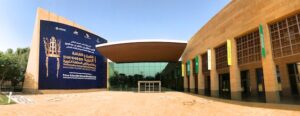
The National Museum is the number three ranked tourist attraction by tripadvisor. This might give you some indication that there aren’t all that many touring opportunities in the immediate area of Riyadh.

The museum was modern. Admission was only 10 riyales. I must admit that I am not a big fan of this type of museum. They started out with several rooms of geology information. That pretty much shut down my touring juices right there.
Quite often my most enjoyable aspect of a museum visit is sitting in a dark theater watching a film about whatever the museum’s theme is. They had a few films today but none of them were very entertaining especially when they were narrated in Arabic! Nope. This museum didn’t get it for me but I was glad I went. Who wouldn’t want to try out the #3 rated attraction in just about any city.
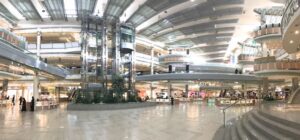
From there I grabbed an Uber ride over to the Kingdom Centre Tower. Kingdom Centre is a huge upscale shopping mall.
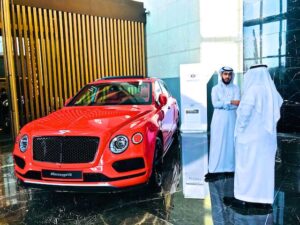
My driver dropped me off at the Four Seasons Hotel. It’s attached to the mall. You might recall that several members of the Saudi royal family were “detained” in this hotel last year and some may still be. If you’re going to be in “jail“ the Four Seasons is just about the best place for it.
Just about every high-end retailer of goods has a shop in this mall. I’ve seen some very nicest shopping malls in all of the world during my visits. I have never seen one more ornate and upscale than the Kingdom Centre Tower mall.
However, there were a few elements of the mall that were just a little bit different than anything else I’ve seen in Saudi Arabia. Every major international mall I have ever visited has a food court. The food court normally has as many as 20 different retailers vying for your culinary business. In almost every case the food mall is located on the upper most level.
In today’s mall the food court was on the lower basement level. They offered a wide variety of food choices. At the counter of most of the restaurants, but not all, there were a couple of signs I hadn’t seen anywhere else during my visits to two shopping malls in Riyadh earlier this week.
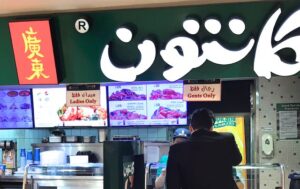
What I saw sort of reminded me of what the American south must have been like in the 1950s and earlier. Today the two signs at the restaurant didn’t say “whites only; blacks only”. They read “men; ladies”. I hadn’t seen anything like that in the malls I have been in earlier this week.
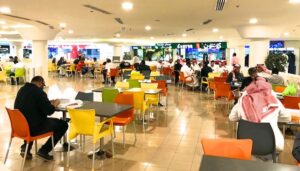
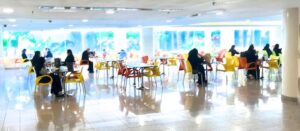
As I looked a little closer I noticed the area where people were eating their lunch. There were two large dining areas in the main part of the food court. Only men were eating there. Then off to the side was a smaller dining room with lots of sunlight and only ladies were having lunch in this room. So who were they discriminating against? Men couldn’t eat with the women and women couldn’t eat with the men! I didn’t get the chance to ask anyone why this was so different than my other experiences in malls this week.
I’ve been really impressed with how nice and friendly the Saudi Arabian people have been. They like America too. America is seen as one of Saudi Arabia’s best partners by the Saudis I met.
To finish off my day I went looking for a souvenir for Carol. Like me, she’s hard to buy for. If I want something I buy it. Carol never wants anything! I also needed something small enough where the gift could fit easily in my luggage for the return home. I found just the right place and the right present in a local tea shop.
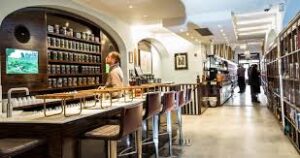
The store had all kinds of upscale tea in bright and colorful metal tin packaging. This was going to fit my needs perfectly. I spent some time talking to the manager and he explained to me the various aspects of several of their choices.
I knew that my hotel was a little bit less than a one mile walk away. When my purchase was finished I asked the manager if he could tell me in which direction to walk from the mall to get back to the hotel.
He pulled out his phone and did a Google Maps type search. He was soon pointing me in the right direction. He sensed I might be a little uncomfortable with finding the hotel. At that point he offered to drive me in his own personal car back to the hotel. I had only met the guy a moment ago and made just a small purchase in his store. He was serious. He would’ve driven me back to the hotel. I thanked him but declined his offer. I ended up finding the hotel on the first shot although walking in Riyadh is not for the faint-hearted. They don’t have uniform sidewalks. There are elevation changes including two and three drop offs from one property owner’s hard scape to the next.
It was now about 3 p.m. I was going to have to get up at about 1 a.m. to begin the process of getting to the airport and ultimately catching my flight at 4 a.m. I decided to take an afternoon nap and see how long I would sleep. My sleeping on this trip has been a bit irregular. On some days I took an afternoon nap. That made sleeping at night a little more difficult.
Today my strategy was to set an alarm every 60 minutes or so. When the alarm went off I would decide whether or not I wanted to sleep any longer. After the first few alarms my body was saying, “keep sleeping”!
I woke up for good at about 10 p.m. I probably slept for a good six hours. I thought that would serve me well for the 18-hour flight trip home. When I did wakeup I dined on my leftover pepperoni Stromboli from today’s mall visit.
My transportation plan from Saudi Arabia to San Clemente would begin with an Uber ride leaving the hotel tonight. Actually I planned to leave the hotel in the early morning at 1:30 a.m. It would be about a 30-minute ride. It would also be my most expensive Uber ride of the trip at about $20-25 U.S.

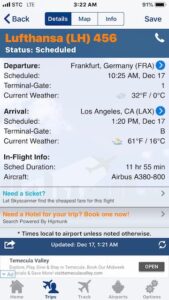
This plan would get me to the airport two hours and 15 minutes in advance of my flight. I figured that would be enough. The check-in process can take a little bit longer on international flights. My first flight would take me from Riyadh, Saudi Arabia to Frankfurt, Germany. That was a six-hour flight. In Frankfurt I had about an hour and a half to connect to a flight back to Los Angeles. That plane ride was scheduled to last a little bit more than 12 hours. If all of that worked well I would land at LAX at 1:30 p.m. on the same day I left Saudi Arabia, Monday.
Little did I know that I was about ready to encounter some trouble, the biggest trouble of the trip. Permit me to elaborate.
I didn’t think much of the staff at the Courtyard Riyadh Olaya Marriott hotel. They had really dropped the ball when my lost airline bag was delivered to the hotel. During most of my conversations with members of the hotel staff they just didn’t seem to “get it”. I was disappointed with them.
When I checked out, my bill came to about 700 Saudi Arabian riyal. I had about 150 riyales in cash. Once I left SA I would have no use for any riyales. I had saved a few small denomination bills for the grandkids as a souvenir.
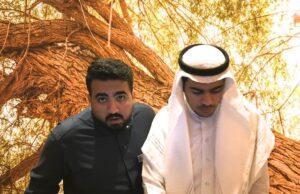
I told the front desk manager I would like to pay for my bill with the 150 riyales I had and the rest of the bill could go on my credit card. He seemed to understand. Then when he handed me my credit card receipt, after I had given him all of my riyales, the credit card balance was STILL 700 riyales. I brought the error to his attention. That’s when things went downhill.
The guy couldn’t figure out how to give me a credit on my credit card. He suggested I keep my riyales. That would be like throwing money down the drain. Once I left Saudi Arabia I wouldn’t need any riyales. I didn’t feel like spending 150 riyales just to be spending them.
The front desk guy brought in two other people. None of them knew how to do a credit. We hemmed and hawed and the entire process took THIRTY MINUTES! They finally agreed to send me a credit on my credit card the next day. At that point all I could do was trust them and I didn’t. I took each of their pictures so I could prove to someone later than I had talked to these three people. They have wasted 30 minutes of my two hour and 15-minute cushion for getting to the airport.
By now my Uber driver had arrived. It was going to be a 30-minute drive from the hotel to the airport. Off we went. The driver didn’t speak much English. The traffic was light as you might imagine at 2 o’clock in the morning.

We were twenty minutes into the ride when I screamed as loud as I could and started swearing! My driver just about drove off the road in his surprise. What was the problem?

I just remembered I had forgotten to clear out the contents of my hotel room safe. That was critical for getting me home. What was in the safe? I had my Bose headphones in there. I had more than $700 in cash in the safe. My car key was in there. Finally, my PASSPORT was in there!!!
Time was of the essence. I considered calling the hotel and asking them to get everything out of the safe and drive it to the airport. However, I knew those guys couldn’t pull that off. We had no choice. We would need to make a U-turn and drive back to the hotel.
I’ve got to give my driver credit. He put the pedal to the medal. However, there was a problem. He began pointing at the car’s dashboard. He was saying something. What was it? “Timmy’s fallen into the well and can’t get out”? No! He needed to stop for gas. OMG.

“How long would that take?” I asked. He told me “about ten minutes”. No! We stopped for gas and were out of there in less than five minutes.
The way I had it figured that with the time it would take to get back to the hotel, run up to my room and get my stuff and then drive back to the airport I would have an hour and five minutes before my flight departed. With an international flight that’s not all that much. I was worried they would close the check-in line with an hour to go. The line closes earlier for international flights.
We arrived at the hotel. I got a new room key and ran to the room. I scooped up all my stuff and put it in a Sketcher’s bag from an earlier purchase this week. I felt like a burglar.
When I returned to the front desk the desk clerk told me my Uber driver was in the bathroom! It’s hard to get everyone on the same page sometimes. I waited a couple of minutes for him to return. His only comment was a sheepish response, “Sorry”. OMG.
From there it was full speed ahead back to the airport. I had to tell the driver which terminal was the international terminal. Outside of that terminal was a line of some 75 people all with lots of baggage. It looked like they were waiting to get inside the terminal. Was the terminal closed? If it was and I had to go to the end of that line I would never make my flight.
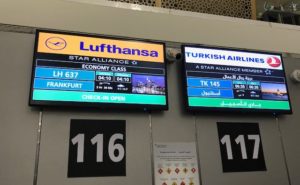
Luckily, that group of people was waiting for something else. I rushed into the terminal and immediately went to the Lufthansa counter. By this time, one hour and three minutes before my flight, no one else was checking their bags. The agent told me, I think, because nobody speaks much English in SA, that I had beaten the deadline by three minutes.
Had I missed the flight I would have to wait 24 hours for tomorrow night’s flight to Frankfort, Germany. I would have to buy another night’s hotel. I would likely have to pay change and re-booking fees of hundreds of dollars. I was lucky. I won’t make that mistake again….at least for a while.
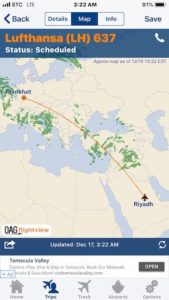

From there everything was a piece of cake. I simply sat in economy and watched movies, played with my laptop and slept for the next 18 flying hours. It’s all part of the fun.
I hope you’ve enjoyed my “story” about Saudi Arabia. I hope at times it made you feel like you were there. Not very many people have ever been or will ever go. I’m glad I got the chance.
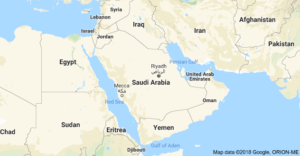
Good day from Diriyah, Saudi Arabia until the next international trackchasing effort…which is in the thinking stages right now.
THE COUNTRY LIST
#82!!
RLR – Randy Lewis Racing Lifetime Trackchasing Countries
# 1 – UNITED STATES OF AMERICA– Peoria Speedway – Mt. Hawley, (oval) – Track #1, Peoria, Illinois – circa 1954 (age 5)
# 2 – CANADA– Cayuga Speedway (oval) – Track #174, Nelles Corner, Ontario – July 31, 1988 (Dick Trickle winner)
# 3 – AUSTRALIA– Parramatta City Raceway (oval) – Track #180, Granville, New South Wales – November 17, 1989 (accompanied by Carol)
# 4 – UNITED KINGDOM– Northhampton International Raceway (oval) – Track #378, Northhampton – June 26, 1999 (accompanied by Carol, Kristy, Jim)
# 5 – NETHERLANDS– Driesum Racetrack (oval) – Track #839, Driesum – May 5, 2005 (accompanied by Roland Vanden Eynde)
# 6 – BELGIUM– Bellekouter oval (oval) – Track #841, Affligem – May 8, 2005 (accompanied by Roland Vanden Eynde)
# 7 – FRANCE– Circuit de Croix en Ternois (road course) – Track #843, Saint-Pol sur-Ternoise – May 8, 2005 (accompanied by Roland Vanden Eynde – 2ndnew country in one day!)
# 8 – GERMANY– Nurburgring (road course) – Track #844, Nurburg – May 13, 2005 (accompanied by Carol, Roland Vanden Eynde)
# 9 – NEW ZEALAND– Western Springs Speedway (oval) – Track #1,134, Western Springs – December 26, 2006 (accompanied by Carol)
# 10 – MEXICO– Triovalo Bernardo Obregon (oval) – Track #1,281, Tiajamulco de Zuniga, Jalisco – October 14, 2007 (accompanied by Carol, J.J., Roger Ward)
# 11 – BARBADOS– Bushy Park Racing Circuit (road course) – Track #1,296, Bushy Park – December 9, 2007
# 12 – THAILAND– Bira Circuit (road course) – Track #1,300, Pattaya – January 19, 2008
# 13 – SOUTH AFRICA– Durban Grand Prix (road course) – Track #1,315, Durban, KwaZulu-Natal – February 24, 2008 (accompanied by J.J. and Will Van Horne)
# 14 – JAMAICA– Dover Raceway (road course) – Track #1,322, Brown’s Town St. Ann – March 24, 2008
# 15 – SWEDEN– Sturup Raceway (road course) – Track #1,335, Malmo – May 10, 2008 (accompanied by Carol)
# 16 – DENMARK– Ring Djursland (road course) – Track #1,336, Tirstrup – May 11, 2008 (accompanied by Carol)
# 17 – CZECH REPUBLIC– Automotodrome BRNO (road course) – Track #1,381, Brno – September 13, 2008
# 18 – AUSTRIA– Lambrechten Stock Car Track (road course) – Track #1,382, Lambrechten – September 14, 2008
# 19 – IRELAND– Tipperary International Raceway (oval) – Track #1,388, Rosegreen – October 26, 2008 (Carol and I visited this track earlier in the year)
# 20 – GUYANA– South Dakota Circuit (road course) – Track #1,390, Timehri – November 2, 2008 (accompanied by Carol)
# 21 – CHINA– The Guia Circuit (road course) – Track #1,392, Macau – November 16, 2008 (accompanied by Carol)
# 22 – COSTA RICA– Autodromo La Guacima (road course) – Track #1,398, La Guacima – November 30, 2008
# 23 – ANDORRA– Grandvalira Circuit (road course) – Track #1,404, Port d’Envalira – January 17, 2009
# 24 – ARGENTINA– Circuito Efren Chemolli (oval) – Track #1,406, Buenos Aires – January 31, 2009 (shared with Jerry Fisher)
# 25 – QATAR– Losail International Circuit (road course) – Track #1,408, Doha – February 13, 2009
# 26 – BAHRAIN– Bahrain International Circuit (road course) – Track #1,410, Sakhir – February 27, 2009 (accompanied by Carol)
# 27 – UNITED ARAB EMIRATES– Dubai Autodrome (road course) – Track #1,411, Dubai – February 28, 2009 (accompanied by Carol)
# 28 – COLOMBIA– Autodromo de Tocancipa (road course) – Track #1,415, Tocancipa – March 22, 2009
# 29 – SPAIN– Motorland Aragon (road course) – Track #1,416, Alcaniz – March 28, 2009
# 30 – PORTUGAL– Circuto de Murca (road course) – Track #1,417, Murca – March 29, 2009
# 31 – ICELAND– Kapelluhraum (road course) – Track #1,420, Hafnafjorour – April 25, 2009 (shared with Will White)
# 32 – HUNGARY– Hungaroring (road course) – Track #1,426, Mogyorod – May 8, 2009 (accompanied by Carol)
# 33 – SWITZERLAND– Hock Ybrig (road course) – Track #1,427, Hoch Ybrig – May 9, 2009 (accompanied by Carol)
# 34 – ITALY– Vighizzolo d’Este Stock Car Track (road course) – Track #1,428, Vighizzolo d’Este – May 10, 2009 (accompanied by Carol)
# 35 – DOMINICAN REPUBLIC– Autodromo Mobil 1 (road course) – Track #1,515, Santo Domingo – December 6, 2009 (accompanied by Carol)
# 36 – MALTA– Ta’Qali Race Track (road course) – Track #1,521, Ta’Qali – February 7, 2010 (accompanied by Carol)
# 37 – FINLAND– Lake Pidisjarvi Ice Track (road course) – Track #1,524, Nivala – February 20, 2010
# 38 – JAPAN– Suzuka Circuit (road course) – Track #1,530, Suzuka – March 21, 2010
# 39 – CHILE– Autodromo de Interlomas (road course) – Track #1,531, Temuco – April 18, 2010
# 40 – MOROCCO– Circuit de Marrakesh (road course) – Track #1,535, Marrakesh – May 1, 2010 (accompanied by Carol)
# 41 – BRAZIL– Circuit de Caruaru – Aryten Senna (road course) – Track #1,540, Caruaru – May 16, 2010 (accompanied by Carol, Jerry Fisher and Katina Spencer)
# 42 – ESTONIA– Laitse Rally Park (road course) – Track #1,571, Laitse – July 24, 2010 (accompanied by Carol)
# 43 – LATVIA– Bikernieki (road course) – Track #1,572, Riga – July 25, 2010 (accompanied by Carol
# 44 – GUATEMALA– Autodromo Pedro Cofino (road course) – Track #1,580, Alotenango – August 15, 2010
# 45 – EL SALVADOR– El Jabali (road course) – Track #1,582, Quezaltepeque – August 22, 2010 (accompanied by Carol)
# 46 – ROMANIA– Bradu (road course) – Track #1,603, Bradu – October 16, 2010
# 47 – BULGARIA– Closed Route – Burgas (road course) – Track #1,604, Burgas – October 17, 2010 (accompanied by Lyubomir and Plamen Simeonov)
# 48 – SOUTH KOREA– Korea International Circuit (road course) – Track #1,605, Yeongam, Jeollanam-Do – October 24, 2010
# 49 – PHILIPPINES– Batangas Racing Circuit (road course) – Track #1,608, Batangas – November 21, 2010
# 50 – NORWAY– Lyngas Motorbane (road course) – Track #1,648, Lier – April 30, 2011
# 51 – MALAYSIA– Sepang International Circuit (road course) – Track #1,656, Sepang – May 28, 2011
# 52 – INDONESIA– Sentul International Circuit (road course) – Track #1,657, Babakan Madang, Boder – May 29, 2011
# 53 – LUXEMBOURG– Alzingen (road course) – Track #1,711, Alzingen – September 4, 2011 (accompanied by Carol)
# 54 – POLAND– Tor Slomczyn (road course) – Track #1,713, Slomczyn – September 11, 2011 (accompanied by Carol)
# 55 – SINGAPORE– Marina Bay (road course) – Track #1,714, Singapore – September 24, 2011 (accompanied by Carol)
# 56 – URUGUAY– Piriapolis Grand Prix (road course) – Track #1,724, Piriapolis – November 12, 2011
# 57 – SRI LANKA– Pannala Race Track (road course) – Track #1,732, Pannala – February 12, 2012
# 58 – ECUADOR– Autodromo Internacional de Yahuarcocha (road course) – Track #1,736, Ibarra – March 11, 2012
# 59 – SLOVAKIA– Slovakia Ring (road course) – Track #1,742, Orechova Puton – April 29, 2012
# 60 – MONACO– Circuit de Monaco (street course) – Track #1,746, Monte Carlo – May 13, 2012 (accompanied by Carol)
# 61 – CROATIA– Automotodrom Grobnik (road course) – Track #1,762, Rijeka – June 23, 2012
# 62 – PERU– Autodromo La Chutana (road course) – Track #1,802, Lima – October 21, 2012 (accompanied by Carol)
# 63 – GREECE– Serres Circuit (road course) – Track #1,807, Serres – November 4, 2012
# 64 – RUSSIA– Moscow Central Hippodrome (oval) – Track #1,824, Moscow – February 23, 2013 (accompanied by Carol)
# 65 – LITHUANIA– Marijampole Autokross Track (road course) – Track #1,842, Marijampole – May 12, 2013 (accompanied by Carol)
# 66 – INDIA– Buddh International Circuit (road course) – Track #1,915, Noida – October 27, 2013 (accompanied by Carol)
# 67 – GEORGIA– Rustavi International Motorpark (road course) – Track #1,916, Rustavi – November 10, 2013
# 68 – TRINIDAD AND TOBAGO– Larry Gomes Stadium (road course) – Track #1,928, Arima – January 26, 2014 (accompanied by Carol)
# 69 – TURKEY– Istanbul Park (road course) – Track #2,035 Akfirat (accompanied by Carol)
# 70 – AZERBAIJAN– Streets of Baku (road course) – Track #2,037, Baku (accompanied by Carol)
# 71 – SERBIA– Usce (road course) – Track #2,224, Belgrade (accompanied by Carol)
# 72 – BOZNIA AND HERZEBOVINA– Zaluzani (road course) – Track #2,235, Zaluzani (accompanied by Boris Miljevic)
# 73 – PANAMA– La Chorrera (road course) – Track #2,290, Circuito Internacional de Panama (accompanied by Carol)
# 74 – ZIMBABWE– Bulawayo Motorsport Park (road course) – Track #2,291, Bulawayo
# 75 – NAMIBIA– Desert Raceway (oval) – Track #2,369, Walvis Bay – 2017
# 76 – MACEDONIA– Skopje Street Course (road course) – Track #2,386, Skopje – 2017
# 77 – UKRAINE– Autodrome Chayka (road course) – Track #2,387, Kiev – 2017
# 78 – BELARUS– Stadium Zarya (oval) – Track #2,421, Minsk – 2018
# 79 – MALDIVES– Hulhumalé Racing Track (road course) – Track #2,425, Hulhumalé – 2018
# 80 – BOLIVIA– Autodromo Santa Cruz (road course) – Track #2,429, Santa Cruz – 2018
# 81 – Moldova– Colonita Autocross (road course) – Track #2,503, Colonita – 2018
# 82 – Saudi Arabia– Ad Diriyah E-Prix (road course) – Track #2,514, Ad Diriyah – 2018
The International Big 3 country count.
- . Randy Lewis, San Clemente, California USA – 82
- . Roland Vanden Eynde, Vilvoorde, Belgium – 52
- . Carol Lewis, San Clemente, California USA – 46
2018 has been an outstanding international trackchasing year, especially considering I started with 77 country visits. I’ve had new country visits to Belarus, Maldives, Bolivia, Moldova and now Saudi Arabia! I can’t imagine a more eclectic group of countries.
LIFETIME TRACKCHASER COMPARISONS
The three most important trackchasing comparisons to me are:
Total lifetime tracks seen
Total “trackchasing countries” seen
Lifetime National Geographic Diversity results
Total Lifetime Tracks
There are no trackchasers currently within 680 tracks of my lifetime total. Don’t blame me.
- . Randy Lewis, San Clemente, California – 2,514
Total Trackchasing Countries
There are no trackchasers currently within 25 countries of my lifetime total.
- . Randy Lewis, San Clemente, California – 82
Current lifetime National Geographic Diversity results
- Randy Lewis, San Clemente, California – 4.14
LIKE TO KNOW MORE ABOUT SAUDI ARABIA – TRACKCHASING COUNTRY #82?

Saudi Arabia – FAST FACTS*
Provided by my friends at Wikipedia and others.
Saudi Arabia, officially the Kingdom of Saudi Arabia, is a country in Western Asiaconstituting the bulk of the Arabian Peninsula. With a land area of approximately 2,150,000 km2 (830,000 sq mi), Saudi Arabia is the largest sovereign state in the Middle East, geographically the fifth-largest in Asia, second-largest in the Arab world after Algeria and 12th-largest in the world. Saudi Arabia is bordered by Jordan and Iraq to the north, Kuwait to the northeast, Qatar, Bahrain, and the United Arab Emirates to the east, Oman to the southeast and Yemento the south. It is separated from Israel and Egypt by the Gulf of Aqaba. It is the only nation with both a Red Sea coast and a Persian Gulf coast, and most of its terrain consists of arid desert, lowland and mountains. Saudi Arabia is the largest economy in the Middle East as of October 2018 and the 18th largest in the world.
The territory that now constitutes Saudi Arabia was the site of several ancient cultures and civilizations. The prehistory of Saudi Arabia shows some of the earliest traces of human activity in the world. The world’s second-largest religion, Islam, emerged in modern-day Saudi Arabia. In the early 7th century, the Islamic prophet Muhammad united the population of Arabia and created a single Islamic religious polity. Following his death in 632, his followers rapidly expanded the territory under Muslim rule beyond Arabia, conquering huge and unprecedented swathes of territory (from the Iberian Peninsula in the West to modern day Pakistan in the East) in a matter of decades. Arab dynasties originating from modern-day Saudi Arabia founded the Rashidun (632–661), Umayyad (661–750), Abbasid (750–1517) and the Fatimid (909–1171) caliphates as well as numerous other dynasties in Asia, Africa and Europe.
The area of modern-day Saudi Arabia formerly consisted of mainly four distinct regions: Hejaz, Najd and parts of Eastern Arabia (Al-Ahsa) and Southern Arabia (‘Asir). The Kingdom of Saudi Arabia was founded in 1932 by Ibn Saud. He united the four regions into a single state through a series of conquests beginning in 1902 with the capture of Riyadh, the ancestral home of his family, the House of Saud. Saudi Arabia has since been an absolute monarchy, effectively a hereditary dictatorship governed along Islamist lines. The ultraconservative Wahhabi religious movement within Sunni Islam has been called “the predominant feature of Saudi culture”, with its global spread largely financed by the oil and gas trade. Saudi Arabia is sometimes called “the Land of the Two Holy Mosques” in reference to Al-Masjid al-Haram (in Mecca) and Al-Masjid an-Nabawi (in Medina), the two holiest places in Islam. As of 2013, the state had a total population of 28.7 million, of which 20 million were Saudi nationals and 8 million were foreigners. As of 2017, the population is 33 million. The state’s official language is Arabic.
Petroleum was discovered on 3 March 1938 and followed up by several other finds in the Eastern Province. Saudi Arabia has since become the world’s second largest oil producer behind the U.S. and exporter, controlling the world’s second largest oil reserves and the sixth largest gas reserves. The kingdom is categorized as a World Bank high-income economy with a high Human Development Index and is the only Arab country to be part of the G-20 major economies. The state has attracted criticism for its treatment of women and use of capital punishment. Saudi Arabia is an autocratic monarchy, has the third-highest military expenditure in the world and SIPRI found that Saudi Arabia was the world’s second largest arms importer in 2010–2014. Saudi Arabia is considered a regional and middle power. In addition to the GCC, it is an active member of the Organisation of Islamic Cooperation and OPEC.
Etymology
Following the unification of the Hejaz and Nejd kingdoms, the new state was named al-Mamlakah al-ʻArabīyah as-Suʻūdīyahby royal decree on 23 September 1932 by its founder, Abdulaziz Al Saud (Ibn Saud). Although this is normally translated as “the Kingdom of Saudi Arabia” in English, it literally means “the Saudi Arab kingdom”, or “the Arab Saudi Kingdom”.
The word “Saudi” is derived from the element as-Suʻūdīyah in the Arabic name of the country, which is a type of adjective known as a nisba, formed from the dynastic name of the Saudi royal family, the Al Saud (Arabic: آل سعود). Its inclusion expresses the view that the country is the personal possession of the royal family. Al Saud is an Arabic name formed by adding the word Al, meaning “family of” or “House of”, to the personal name of an ancestor. In the case of the Al Saud, this is the father of the dynasty’s 18th-century founder, Muhammad bin Saud.
History
Middle Ages and rise of Islam
Shortly before the advent of Islam, apart from urban trading settlements (such as Mecca and Medina), much of what was to become Saudi Arabia was populated by nomadic pastoral tribal societies. The Islamic prophet Muhammad was born in Mecca in about 571 CE. In the early 7th century, Muhammad united the various tribes of the peninsula and created a single Islamic religious polity. Following his death in 632, his followers rapidly expanded the territory under Muslim rule beyond Arabia, conquering huge and unprecedented swathes of territory (from the Iberian Peninsula in west to modern day Pakistan in east) in a matter of decades. Arabia soon became a more politically peripheral region of the Muslim world as the focus shifted to the vast and newly conquered lands.
At its greatest extent, the Umayyad Caliphate (661–750) covered 11,100,000 km2 (4,300,000 sq mi) and 62 million people (29% of the world’s population), making it one of the largest empires in history in both area and proportion of the world’s population. It was also larger than any previous empire in history.
Arab dynasties, originating from modern-day Saudi Arabia, Hejaz in particular, founded the Rashidun (632–661), Umayyad (661–750), Abbasid(750–1517) and the Fatimid (909–1171) caliphates.
From the 10th century to the early 20th century Mecca and Medina were under the control of a local Arab ruler known as the Sharif of Mecca, but at most times the Sharif owed allegiance to the ruler of one of the major Islamic empires based in Baghdad, Cairo or Istanbul. Most of the remainder of what became Saudi Arabia reverted to traditional tribal rule.
Foundation of the Saud dynasty
The emergence of what was to become the Saudi royal family, known as the Al Saud, began in Nejd in central Arabia in 1744, when Muhammad bin Saud, founder of the dynasty, joined forces with the religious leader Muhammad ibn Abd al-Wahhab, founder of the Wahhabi movement, a strict puritanical form of Sunni Islam. This alliance formed in the 18th century provided the ideological impetus to Saudi expansion and remains the basis of Saudi Arabian dynastic rule today.
The first “Saudi state” established in 1744 in the area around Riyadh, rapidly expanded and briefly controlled most of the present-day territory of Saudi Arabia, sacking Karbala in 1802 and capturing Mecca in 1803, but was destroyed by 1818 by the Ottoman viceroy of Egypt, Mohammed Ali Pasha. A much smaller second “Saudi state”, located mainly in Nejd, was established in 1824. Throughout the rest of the 19th century, the Al Saud contested control of the interior of what was to become Saudi Arabia with another Arabian ruling family, the Al Rashid. By 1891, the Al Rashid were victorious and the Al Saud were driven into exile in Kuwait.
At the beginning of the 20th century, the Ottoman Empire continued to control or have a suzerainty over most of the peninsula. Subject to this suzerainty, Arabia was ruled by a patchwork of tribal rulers, with the Sharif of Mecca having pre-eminence and ruling the Hejaz. In 1902, Abdul Rahman’s son, Abdul Aziz—later to be known as Ibn Saud—recaptured control of Riyadh bringing the Al Saud back to Nejd. Ibn Saud gained the support of the Ikhwan, a tribal army inspired by Wahhabism and led by Faisal Al-Dawish, and which had grown quickly after its foundation in 1912. With the aid of the Ikhwan, Ibn Saud captured Al-Ahsa from the Ottomans in 1913.
In 1916, with the encouragement and support of Britain (which was fighting the Ottomans in World War I), the Sharif of Mecca, Hussein bin Ali, led a pan-Arab revolt against the Ottoman Empire to create a united Arab state. Although the Arab Revolt of 1916 to 1918 failed in its objective, the Allied victory in World War I resulted in the end of Ottoman suzerainty and control in Arabia.
Ibn Saud avoided involvement in the Arab Revolt, and instead continued his struggle with the Al Rashid. Following the latter’s final defeat, he took the title Sultan of Nejd in 1921. With the help of the Ikhwan, the Hejaz was conquered in 1924–25 and on 10 January 1926, Ibn Saud declared himself King of the Hejaz. A year later, he added the title of King of Nejd. For the next five years, he administered the two parts of his dual kingdom as separate units.
After the conquest of the Hejaz, the Ikhwan leadership’s objective switched to expansion of the Wahhabist realm into the British protectorates of Transjordan, Iraq and Kuwait, and began raiding those territories. This met with Ibn Saud’s opposition, as he recognized the danger of a direct conflict with the British. At the same time, the Ikhwan became disenchanted with Ibn Saud’s domestic policies which appeared to favor modernization and the increase in the number of non-Muslim foreigners in the country. As a result, they turned against Ibn Saud and, after a two-year struggle, were defeated in 1929 at the Battle of Sabilla, where their leaders were massacred. On 23 September 1932, the two kingdoms of the Hejaz and Nejd were united as the Kingdom of Saudi Arabia, and that date is now a national holiday called Saudi National Day.
Post-unification
The new kingdom was reliant on limited agriculture and pilgrimage revenues. In 1938, vast reserves of oil were discovered in the Al-Ahsa region along the coast of the Persian Gulf, and full-scale development of the oil fields began in 1941 under the US-controlled Aramco (Arabian American Oil Company). Oil provided Saudi Arabia with economic prosperity and substantial political leverage internationally.
Cultural life rapidly developed, primarily in the Hejaz, which was the center for newspapers and radio. However, the large influx of foreign workers in Saudi Arabia in the oil industry increased the pre-existing propensity for xenophobia. At the same time, the government became increasingly wasteful and extravagant. By the 1950s this had led to large governmental deficits and excessive foreign borrowing.
In 1953, Saud of Saudi Arabia succeeded as the king of Saudi Arabia, on his father’s death, until 1964 when he was deposed in favor of his half brother Faisal of Saudi Arabia, after an intense rivalry, fueled by doubts in the royal family over Saud’s competence. In 1972, Saudi Arabia gained a 20% control in Aramco, thereby decreasing US control over Saudi oil.
In 1973, Saudi Arabia led an oil boycott against the Western countries that supported Israel in the Yom Kippur War against Egypt and Syria. Oil prices quadrupled. In 1975, Faisal was assassinated by his nephew, Prince Faisal bin Musaid and was succeeded by his half-brother King Khalid.
By 1976, Saudi Arabia had become the largest oil producer in the world. Khalid’s reign saw economic and social development progress at an extremely rapid rate, transforming the infrastructure and educational system of the country; in foreign policy, close ties with the US were developed. In 1979, two events occurred which greatly concerned the government, and had a long-term influence on Saudi foreign and domestic policy. The first was the Iranian Islamic Revolution. It was feared that the country’s Shi’ite minority in the Eastern Province (which is also the location of the oil fields) might rebel under the influence of their Iranian co-religionists. There were several anti-government uprisings in the region such as the 1979 Qatif Uprising.
The second event was the Grand Mosque Seizure in Mecca by Islamist extremists. The militants involved were in part angered by what they considered to be the corruption and un-Islamic nature of the Saudi government. The government regained control of the mosque after 10 days and those captured were executed. Part of the response of the royal family was to enforce a much stricter observance of traditional religious and social norms in the country (for example, the closure of cinemas) and to give the Ulema a greater role in government. Neither entirely succeeded as Islamism continued to grow in strength.
In 1980, Saudi Arabia bought out the American interests in Aramco.
King Khalid died of a heart attack in June 1982. He was succeeded by his brother, King Fahd, who added the title “Custodian of the Two Holy Mosques” to his name in 1986 in response to considerable fundamentalist pressure to avoid use of “majesty” in association with anything except God. Fahd continued to develop close relations with the United States and increased the purchase of American and British military equipment.
The vast wealth generated by oil revenues was beginning to have an even greater impact on Saudi society. It led to rapid technological (but not cultural) modernisation, urbanization, mass public education and the creation of new media. This and the presence of increasingly large numbers of foreign workers greatly affected traditional Saudi norms and values. Although there was dramatic change in the social and economic life of the country, political power continued to be monopolized by the royal family leading to discontent among many Saudis who began to look for wider participation in government.
In the 1980s, Saudi Arabia spent $25 billion in support of Saddam Hussein in the Iran–Iraq War. However, Saudi Arabia condemned the Iraqi invasion of Kuwait in 1990 and asked the US to intervene. King Fahd allowed American and coalition troops to be stationed in Saudi Arabia. He invited the Kuwaiti government and many of its citizens to stay in Saudi Arabia, but expelled citizens of Yemen and Jordan because of their governments’ support of Iraq. In 1991, Saudi Arabian forces were involved both in bombing raids on Iraq and in the land invasion that helped to liberate Kuwait.
Saudi Arabia’s relations with the West began to cause growing concern among some of the ulema and students of sharia law and was one of the issues that led to an increase in Islamist terrorismin Saudi Arabia, as well as Islamist terrorist attacks in Western countries by Saudi nationals. Osama bin Laden was a Saudi national (until stripped of his nationality in 1994) and was responsible for the 1998 U.S. embassy bombings in East Africa and the 2000 USS Cole bombing near the port of Aden, Yemen. 15 of the 19 terrorists involved in September 11 attacks in New York City, Washington, D.C., and near Shanksville, Pennsylvania were Saudi nationals. Many Saudis who did not support the Islamist terrorists were nevertheless deeply unhappy with the government’s policies.
Islamism was not the only source of hostility to the government. Although now extremely wealthy, Saudi Arabia’s economy was near stagnant. High taxes and a growth in unemployment have contributed to discontent, and has been reflected in a rise in civil unrest, and discontent with the royal family. In response, a number of limited “reforms” were initiated by King Fahd. In March 1992, he introduced the “Basic Law”, which emphasised the duties and responsibilities of a ruler. In December 1993, the Consultative Council was inaugurated. It is composed of a chairman and 60 members—all chosen by the King. The King’s intent was to respond to dissent while making as few actual changes in the status quo as possible. Fahd made it clear that he did not have democracy in mind: “A system based on elections is not consistent with our Islamic creed, which [approves of] government by consultation [shūrā].”
In 1995, Fahd suffered a debilitating stroke, and the Crown Prince, Abdullah, assumed the role of de facto regent, taking on the day-to-day running of the country. However, his authority was hindered by conflict with Fahd’s full brothers (known, with Fahd, as the “Sudairi Seven”). From the 1990s, signs of discontent continued and included, in 2003 and 2004, a series of bombings and armed violence in Riyadh, Jeddah, Yanbu and Khobar. In February–April 2005, the first-ever nationwide municipal elections were held in Saudi Arabia. Women were not allowed to take part in the poll.
In 2005, King Fahd died and was succeeded by Abdullah, who continued the policy of minimum reform and clamping down on protests. The king introduced a number of economic reforms aimed at reducing the country’s reliance on oil revenue: limited deregulation, encouragement of foreign investment, and privatization. In February 2009, Abdullahannounced a series of governmental changes to the judiciary, armed forces, and various ministries to modernize these institutions including the replacement of senior appointees in the judiciary and the Mutaween (religious police) with more moderate individuals and the appointment of the country’s first female deputy minister.
On 29 January 2011, hundreds of protesters gathered in the city of Jeddah in a rare display of criticism against the city’s poor infrastructure after deadly floods swept through the city, killing eleven people. Police stopped the demonstration after about 15 minutes and arrested 30 to 50 people.
Since 2011, Saudi Arabia has been affected by its own Arab Spring protests. In response, King Abdullah announced on 22 February 2011 a series of benefits for citizens amounting to $36 billion, of which $10.7 billion was earmarked for housing. No political reforms were announced as part of the package, though some prisoners indicted for financial crimes were pardoned. On 18 March the same year, King Abdullah announced a package of $93 billion, which included 500,000 new homes to a cost of $67 billion, in addition to creating 60,000 new security jobs.
Although male-only municipal elections were held on 29 September 2011, Abdullah allowed women to vote and be elected in the 2015 municipal elections, and also to be nominated to the Shura Council.
Politics
Saudi Arabia is an absolute monarchy. However, according to the Basic Law of Saudi Arabia adopted by royal decree in 1992, the king must comply with Sharia (Islamic law) and the Quran, while the Quran and the Sunnah (the traditions of Muhammad) are declared to be the country’s constitution. No political parties or national elections are permitted. Critics regard it as a totalitarian dictatorship. The Economist rated the Saudi government as the fifth most authoritarian government out of 167 rated in its 2012 Democracy Index, and Freedom House gave it its lowest “Not Free” rating, 7.0 (“1=best, 7=worst”) for 2013.
In the absence of national elections and political parties, politics in Saudi Arabia takes place in two distinct arenas: within the royal family, the Al Saud, and between the royal family and the rest of Saudi society. Outside of the Al-Saud, participation in the political process is limited to a relatively small segment of the population and takes the form of the royal family consulting with the ulema, tribal sheikhs and members of important commercial families on major decisions. This process is not reported by the Saudi media.
By custom, all males of full age have a right to petition the king directly through the traditional tribal meeting known as the majlis. In many ways the approach to government differs little from the traditional system of tribal rule. Tribal identity remains strong and, outside of the royal family, political influence is frequently determined by tribal affiliation, with tribal sheikhs maintaining a considerable degree of influence over local and national events. As mentioned earlier, in recent years there have been limited steps to widen political participation such as the establishment of the Consultative Council in the early 1990s and the National Dialogue Forum in 2003.
The rule of the Al Saud faces political opposition from four sources: Sunni Islamist activism; liberal critics; the Shi’ite minority—particularly in the Eastern Province; and long-standing tribal and regionalist particularistic opponents (for example in the Hejaz). Of these, the Islamic activists have been the most prominent threat to the government and have in recent years perpetrated a number of violent or terrorist acts in the country. However, open protest against the government, even if peaceful, is not tolerated.
Monarchy and royal family
The king combines legislative, executive, and judicial functions and royal decrees form the basis of the country’s legislation. The king is also the prime minister, and presides over the Council of Ministers of Saudi Arabia and Consultative Assembly of Saudi Arabia.
The royal family dominates the political system. The family’s vast numbers allow it to control most of the kingdom’s important posts and to have an involvement and presence at all levels of government. The number of princes is estimated to be at least 7,000, with most power and influence being wielded by the 200 or so male descendants of Ibn Saud. The key ministries are generally reserved for the royal family, as are the thirteen regional governorships.
Long term political and government appointments have resulted in the creation of “power fiefdoms” for senior princes, such as those of King Abdullah, who had been Commander of the National Guard since 1963 (until 2010, when he appointed his son to replace him), former Crown Prince Sultan, Minister of Defence and Aviation from 1962 to his death in 2011, former crown prince Prince Nayef who was the Minister of Interior from 1975 to his death in 2012, Prince Saud who had been Minister of Foreign Affairs since 1975 and current King Salman, who was Minister of Defense and Aviation before he was crown prince and Governor of the Riyadh Province from 1962 to 2011. The current Minister of Defense is Prince Mohammad bin Salman, the son of King Salman and Crown Prince.
The royal family is politically divided by factions based on clan loyalties, personal ambitions and ideological differences. The most powerful clan faction is known as the ‘Sudairi Seven’, comprising the late King Fahd and his full brothers and their descendants. Ideological divisions include issues over the speed and direction of reform, and whether the role of the ulema should be increased or reduced. There were divisions within the family over who should succeed to the throne after the accession or earlier death of Prince Sultan. When prince Sultan died before ascending to the throne on 21 October 2011, King Abdullah appointed Prince Nayef as crown prince. The following year Prince Nayef also died before ascending to the throne.
As many as 500 princes, government ministers, and business people, including Prince Fahd bin Abdullah, were arrested by Saudi Arabian authorities as part of the 2017 Saudi Arabian purge.
The Saudi government and the royal family have often, over many years, been accused of corruption. In a country that is said to “belong” to the royal family and is named for them, the lines between state assets and the personal wealth of senior princes are blurred. The extent of corruption has been described as systemic and endemic, and its existence was acknowledged and defended by Prince Bandar bin Sultan (a senior member of the royal family[148]) in an interview in 2001.
Although corruption allegations have often been limited to broad undocumented accusations, specific allegations were made in 2007, when it was claimed that the British defence contractor BAE Systems had paid Prince Bandar US$2 billion in bribes relating to the Al-Yamamah arms deal. Prince Bandar denied the allegations. Investigations by both US and UK authorities resulted, in 2010, in plea bargain agreements with the company, by which it paid $447 million in fines but did not admit to bribery.
Transparency International in its annual Corruption Perceptions Index for 2010 gave Saudi Arabia a score of 4.7 (on a scale from 0 to 10 where 0 is “highly corrupt” and 10 is “highly clean”). Saudi Arabia has undergone a process of political and social reform, such as to increase public transparency and good governance. However, nepotism and patronage are widespread when doing business in the country. The enforcement of the anti-corruption laws is selective and public officials engage in corruption with impunity. A number of prominent Saudi Arabian princes, government ministers, and businesspeople, including Prince Al-Waleed bin Talal, were arrested in Saudi Arabia in November 2017.
There has been mounting pressure to reform and modernize the royal family’s rule, an agenda championed by King Abdullah both before and after his accession in 2005. The creation of the Consultative Council in the early 1990s did not satisfy demands for political participation, and, in 2003, an annual National Dialogue Forum was announced that would allow selected professionals and intellectuals to publicly debate current national issues, within certain prescribed parameters. In 2005, the first municipal elections were held. In 2007, the Allegiance Council was created to regulate the succession. In 2009, the king made significant personnel changes to the government by appointing reformers to key positions and the first woman to a ministerial post. However, these changes have been criticized as being too slow or merely cosmetic.
Saudi Arabia is almost unique in giving the ulema (the body of Islamic religious leaders and jurists) a direct role in government. The preferred ulema are of the Salafi persuasion. The ulema have also been a key influence in major government decisions, for example the imposition of the oil embargo in 1973and the invitation to foreign troops to Saudi Arabia in 1990. In addition, they have had a major role in the judicial and education systems and a monopoly of authority in the sphere of religious and social morals.
By the 1970s, as a result of oil wealth and the modernization of the country initiated by King Faisal, important changes to Saudi society were under way and the power of the ulema was in decline. However, this changed following the seizure of the Grand Mosque in Mecca in 1979 by Islamist radicals. The government’s response to the crisis included strengthening the ulema’s powers and increasing their financial support: in particular, they were given greater control over the education system and allowed to enforce stricter observance of Wahhabi rules of moral and social behaviour. After his accession to the throne in 2005, King Abdullah took steps to reduce the powers of the ulema, for instance transferring control over girls’ education to the Ministry of Education.
The ulema have historically been led by the Al ash-Sheikh, the country’s leading religious family. The Al ash-Sheikh are the descendants of Muhammad ibn Abd al-Wahhab, the 18th-century founder of the Wahhabi form of Sunni Islam which is today dominant in Saudi Arabia. The family is second in prestige only to the Al Saud (the royal family) with whom they formed a “mutual support pact” and power-sharing arrangement nearly 300 years ago. The pact, which persists to this day, is based on the Al Saud maintaining the Al ash-Sheikh’s authority in religious matters and upholding and propagating Wahhabi doctrine. In return, the Al ash-Sheikh support the Al Saud’s political authority thereby using its religious-moral authority to legitimize the royal family’s rule. Although the Al ash-Sheikh’s domination of the ulema has diminished in recent decades, they still hold the most important religious posts and are closely linked to the Al Saud by a high degree of intermarriage.
Legal system
The primary source of law is the Islamic Sharia derived from the teachings of the Qur’an and the Sunnah (the traditions of the Prophet). Saudi Arabia is unique among modern Muslim states in that Sharia is not codified and there is no system of judicial precedent, giving judges the power to use independent legal reasoning to make a decision. Saudi judges tend to follow the principles of the Hanbali school of jurisprudence (or fiqh) found in pre-modern textsand noted for its literalist interpretation of the Qur’an and hadith.
Because the judge is empowered to disregard previous judgments (either his own or of other judges) and may apply his personal interpretation of Sharia to any particular case, divergent judgements arise even in apparently identical cases, making predictability of legal interpretation difficult. The Sharia court system constitutes the basic judiciary of Saudi Arabia and its judges (qadi) and lawyers form part of the ulema, the country’s Islamic scholars.
Royal decrees are the other main source of law; but are referred to as regulations rather than laws because they are subordinate to the Sharia. Royal decrees supplement Sharia in areas such as labor, commercial and corporate law. Additionally, traditional tribal law and custom remain significant. Extra-Sharia government tribunals usually handle disputes relating to specific royal decrees. Final appeal from both Sharia courts and government tribunals is to the King and all courts and tribunals follow Sharia rules of evidence and procedure.
The Saudi system of justice has been criticized for its “ultra-puritanical judges”, who are often harsh in their sentencing (with beheading for the crime of witchcraft), but also sometimes overly lenient (for cases of rape or wife-beating) and slow, for example leaving thousands of abandoned women unable to secure a divorce. The system has also been criticized for being arcane, lacking in some of the safeguards of justice, and unable to deal with the modern world. In 2007, King Abdullah issued royal decrees reforming the judiciary and creating a new court system, and, in 2009, the King made a number of significant changes to the judiciary’s personnel at the most senior level by bringing in a younger generation.
Capital and physical punishments imposed by Saudi courts, such as beheading, stoning (to death), amputation, crucifixion and lashing, as well as the sheer number of executions have been strongly criticized. The death penalty can be imposed for a wide range of offences including murder, rape, armed robbery, repeated drug use, apostasy, adultery, witchcraft and sorcery and can be carried out by beheading with a sword, stoning or firing squad, followed by crucifixion. The 345 reported executions between 2007 and 2010 were all carried out by public beheading. The last reported execution for sorcery took place in September 2014.
Although repeated theft can be punishable by amputation of the right hand, only one instance of judicial amputation was reported between 2007 and 2010. Homosexual acts are punishable by flogging or death. Atheism or “calling into question the fundamentals of the Islamic religion on which this country is based” is considered a terrorist crime. Lashings are a common form of punishment and are often imposed for offences against religion and public morality such as drinking alcohol and neglect of prayer and fasting obligations.
Retaliatory punishments, or Qisas, are practised: for instance, an eye can be surgically removed at the insistence of a victim who lost his own eye. Families of someone unlawfully killed can choose between demanding the death penalty or granting clemency in return for a payment of diyya (blood money), by the perpetrator.
Even after allowing women to drive and work, public places in Saudi Arabia are still gender-segregated and the kingdom has very strict laws on how unrelated men and women can dine together. In September 2018, a man was arrested by the Saudi authorities for appearing in a video with his female colleague while having breakfast at a hotel, where they both work.
Human rights
Western-based organizations such as Amnesty International, Human Rights Watch and Freedom House condemn both the Saudi criminal justice system and its severe punishments. There are no jury trials in Saudi Arabia and courts observe few formalities. Human Rights Watch, in a 2008 report, noted that a criminal procedure code had been introduced for the first time in 2002, but it lacked some basic protections and, in any case, had been routinely ignored by judges. Those arrested are often not informed of the crime of which they are accused or given access to a lawyer and are subject to abusive treatment and torture if they do not confess. At trial, there is a presumption of guilt and the accused is often unable to examine witnesses and evidence or present a legal defense. Most trials are held in secret. An example of sentencing is that UK pensioner and cancer victim Karl Andree, aged 74, faced 360 lashes for home brewing alcohol. He was later released due to intervention by the British government.
Saudi Arabia is widely accused of having one of the worst human rights records in the world. Human rights issues that have attracted strong criticism include the extremely disadvantaged position of women, capital punishment for homosexuality, religious discrimination, the lack of religious freedom and the activities of the religious police
Ali Mohammed Baqir al-Nimr was arrested in 2012 when he was 17 years old for taking part in an anti-government protests in Saudi Arabia during the Arab Spring. In May 2014, Ali al-Nimr was sentenced to be publicly beheaded and crucified.
In 2013, the government deported thousands of non-Saudis, many of them who were working illegally in the country or had overstayed their visas. Many reports abound, of foreigner workers being tortured either by employers or others.[208] This resulted in many basic services suffering from a lack of workers, as many Saudi Arabian citizens are not keen on working in blue collar jobs.
On 2 October 2018, Saudi journalist and Washington Post columnist Jamal Khashoggi went missing after entering the Saudi consulate in Istanbul, Turkey. According to Turkish government sources there is audio and video evidence for him having been murdered and dismembered inside the consulate.
Foreign relations
Since 1960, as a founding member of OPEC, its oil pricing policy has been generally to stabilize the world oil market and try to moderate sharp price movements so as to not jeopardise the Western economies.
Between the mid-1970s and 2002 Saudi Arabia expended over $70 billion in “overseas development aid”. However, there is evidence that the vast majority was, in fact, spent on propagating and extending the influence of Wahhabism at the expense of other forms of Islam. There has been an intense debate over whether Saudi aid and Wahhabism has fomented extremism in recipient countries. The two main allegations are that, by its nature, Wahhabism encourages intolerance and promotes terrorism. Counting only the non-Muslim-majority countries, Saudi Arabia has paid for the construction of 1359 mosques, 210 Islamic centres, 202 colleges and 2000 schools.
Saudi Arabia and the United States are strategic allies, and since President Barack Obama took office in 2009, the U.S. has sold $110 billion in arms to Saudi Arabia. However, the relationship between Saudi Arabia and the United States became strained and have witnessed major decline during the last years of the Obama administration, although Obama had authorized U.S. forces to provide logistical and intelligence support to the Saudis in their military intervention in Yemen, establishing a joint coordination planning cell with the Saudi military that is helping manage the war, and CIA used Saudi bases for drone assassinations in Yemen. In the first decade of the 21st century the Saudi Arabia paid approximately $100 million to American firms to lobby the U.S. government. On May 20, 2017, President Donald Trump and King Salman signed a series of letters of intent for Saudi Arabia to purchase arms from the United States totaling US$110 billion immediately, and $350 billion over 10 years.
The relations with the U.S. became strained following 9/11. American politicians and media accused the Saudi government of supporting terrorism and tolerating a jihadist culture. Indeed, Osama bin Laden and fifteen out of the nineteen 9/11 hijackers were from Saudi Arabia; in ISIL-occupied Raqqa, in mid-2014, all 12 judges were Saudi. The leaked U.S. Department of State memo, dated 17 August 2014, says that “governments of Qatar and Saudi Arabia…are providing clandestine financial and logistic support to ISIS and other radical groups in the region.” According to former U.S. Secretary of State Hillary Clinton, “Saudi Arabia remains a critical financial support base for al-Qaida, the Taliban, LeT and other terrorist groups… Donors in Saudi Arabia constitute the most significant source of funding to Sunni terrorist groups worldwide.” Former CIA director James Woolsey described it as “the soil in which Al-Qaeda and its sister terrorist organizations are flourishing.” The Saudi government denies these claims or that it exports religious or cultural extremism. In April 2016, Saudi Arabia has threatened to sell off $750 billion in Treasury securities and other U.S. assets if Congress passes a bill that would allow the Saudi government to be sued over 9/11. In September 2016, the Congress passed the Justice Against Sponsors of Terrorism Act that would allow relatives of victims of the September 11 attacks to sue Saudi Arabia for its government’s alleged role in the attacks. Congress overwhelmingly rejected President Barack Obama’s veto.
In the Arab and Muslim worlds, Saudi Arabia is considered to be pro-Western and pro-American, and it is certainly a long-term ally of the United States. However, thisand Saudi Arabia’s role in the 1991 Persian Gulf War, particularly the stationing of U.S. troops on Saudi soil from 1991, prompted the development of a hostile Islamist response internally. As a result, Saudi Arabia has, to some extent, distanced itself from the U.S. and, for example, refused to support or to participate in the U.S.-led invasion of Iraq in 2003.
China and Saudi Arabia are major allies, with relationship between the two countries growing significantly in recent decades. Majority of Saudi Arabians also expressed a favorable view of China.
The consequences of the 2003 invasion and the Arab Spring led to increasing alarm within the Saudi monarchy over the rise of Iran’s influence in the region. These fears were reflected in comments of King Abdullah, who privately urged the United States to attack Iran and “cut off the head of the snake”.The tentative rapprochement between the US and Iran that began in secret in 2011 was said to be feared by the Saudis, and, during the run up to the widely welcomed deal on Iran’s nuclear programme that capped the first stage of US–Iranian détente, Robert Jordan, who was U.S. ambassador to Riyadh from 2001 to 2003, said “[t]he Saudis’ worst nightmare would be the [Obama] administration striking a grand bargain with Iran.” A trip to Saudi by US President Barack Obama in 2014 included discussions of US–Iran relations, though these failed to resolve Riyadh’s concerns.
Saudi Arabia has been seen as a moderating influence in the Arab–Israeli conflict, periodically putting forward a peace plan between Israel and the Palestinians and condemning Hezbollah. Following the Arab Spring Saudi Arabia offered asylum to deposed President Zine El Abidine Ben Ali of Tunisia and King Abdullah telephoned President Hosni Mubarak of Egypt (prior to his deposition) to offer his support. In early 2014 relations with Qatar became strained over its support for the Muslim Brotherhood, and Saudi Arabia’s belief that Qatar was interfering in its affairs. In August 2014 both countries appeared to be exploring ways of ending the rift. Saudi Arabia and its allies have criticized Qatar-based TV channel Al Jazeera and Qatar’s relations with Iran. In 2017, Saudi Arabia imposed a land, naval and air blockade on Qatar.
Saudi Arabia halted new trade and investment dealings with Canada and suspended diplomatic ties in a dramatic escalation of a dispute over the kingdom’s arrest of a women rights activists on 6 August 2018.
Tensions have escalated between the Saudi and its allies after the disappearance of Jamal Khashoggi from the Saudi consulate in Istanbul. Turkish officials are highly skeptical of Khashoggi being murdered inside the consulate; this has strained the already suffering Saudi Arabia–Turkey relations. As stated by Ozgur Unluhisarcikli, director of the German Marshall Fund’s Ankara office “Turkey is maintaining a very delicate balance in its relations with Saudi Arabia. The relations have the potential of evolving into a crisis at any moment.”
The pressure on Saudi to reveal the insights about Khashoggi’s disappearance from the US and other European countries has increased. Saudi-US relations took an ugly turn on 14 October 2018, when Trump promised “severe punishment” if the royal court was responsible for Khashoggis’ death. The Saudi Foreign Ministry retaliated with an equal statement saying, “it will respond with greater action,” indicating the kingdom’s “influential and vital role in the global economy.” A joint statement was issued by Britain, France and Germany also demanding a “credible investigation to establish the truth about what happened, and — if relevant — to identify those bearing responsibility for the disappearance of Jamal Khashoggi, and ensure that they are held to account.”
The U.S. expects its Gulf allies involved in the coalition in Yemen to put in more efforts and address the rising concerns about the millions that have been pushed to the brink of famine. According to the United Nations, the Arabian peninsula nation is home to the world’s worst humanitarian crisis. More than 50,000 children in Yemen died from starvation in 2017. The famine in Yemen is the direct result of the Saudi-led intervention and blockade of the rebel-held area.
In the wake of Jamal Khashoggi’s murder in October 2018, the US secretary of state Mike Pompeo and the US defence secretary Jim Mattis have called for a ceasefire in Yemen within 30 days followed by UN-initiated peace talks. Pompeo has asked Saudi Arabia and the UAE to stop their airstrikes on populated areas in Yemen. Theresa May backed the US call to end the coalition. President of the International Rescue Committee David Miliband called the US announcement as “the most significant breakthrough in the war in Yemen for four years”.
Military
Saudi Arabia has one of the highest percentages of military expenditure in the world, spending more than 10% of its GDP in its military. The Saudi military consists of the Royal Saudi Land Forces, the Royal Saudi Air Force, the Royal Saudi Navy, the Royal Saudi Air Defense, the Saudi Arabian National Guard(SANG, an independent military force), and paramilitary forces, totaling nearly 200,000 active-duty personnel. In 2005 the armed forces had the following personnel: the army, 75,000; the air force, 18,000; air defense, 16,000; the navy, 15,500 (including 3,000 marines); and the SANG had 75,000 active soldiers and 25,000 tribal levies. In addition, there is an Al Mukhabarat Al A’amah military intelligence service.
The kingdom has a long-standing military relationship with Pakistan, it has long been speculated that Saudi Arabia secretly funded Pakistan’s atomic bomb programme and seeks to purchase atomic weapons from Pakistan, in near future. The SANG is not a reserve but a fully operational front-line force, and originated out of Ibn Saud’s tribal military-religious force, the Ikhwan. Its modern existence, however, is attributable to it being effectively Abdullah’sprivate army since the 1960s and, unlike the rest of the armed forces, is independent of the Ministry of Defense and Aviation.
The SANG has been a counterbalance to the Sudairi faction in the royal family: The late prince Sultan, former Minister of Defense and Aviation, was one of the so-called ‘Sudairi Seven’ and controlled the remain.
Spending on defense and security has increased significantly since the mid-1990s and was about US$63.7 billion, as of 2016. Saudi Arabia ranks among the top 10 in the world in government spending for its military, representing about 7% of gross domestic product in 2005. Its modern high-technology arsenal makes Saudi Arabia among the world’s most densely armed nations, with its military equipment being supplied primarily by the US, France and Britain.
The United States sold more than $80 billion in military hardware between 1951 and 2006 to the Saudi military. On 20 October 2010, the U.S. State Department notified Congress of its intention to make the biggest arms sale in American history—an estimated $60.5 billion purchase by the Kingdom of Saudi Arabia. The package represents a considerable improvement in the offensive capability of the Saudi armed forces. 2013 saw Saudi military spending climb to $67bn, overtaking that of the UK, France and Japan to place fourth globally.
The United Kingdom has also been a major supplier of military equipment to Saudi Arabia since 1965. Since 1985, the UK has supplied military aircraft—notably the Tornado and Eurofighter Typhoon combat aircraft—and other equipment as part of the long-term Al-Yamamah arms deal estimated to have been worth £43 billion by 2006 and thought to be worth a further £40 billion. In May 2012, British defence giant BAE signed a £1.9bn ($3bn) deal to supply Hawk trainer jets to Saudi Arabia.
According to the Stockholm International Peace Research Institute, SIPRI, in 2010–14 Saudi Arabia became the world’s second largest arms importer, receiving four times more major arms than in 2005–2009. Major imports in 2010–14 included 45 combat aircraft from the UK, 38 combat helicopters from the USA, 4 tanker aircraft from Spain and over 600 armoured vehicles from Canada. Saudi Arabia has a long list of outstanding orders for arms, including 27 more combat aircraft from the UK, 154 combat aircraft from the USA and a large number of armoured vehicles from Canada. Saudi Arabia received 41 per cent of UK arms exports in 2010–14. France authorized $18 billion in weapons sales to Saudi Arabia in 2015 alone. The $15 billion arms deal with Saudi Arabia is believed to be the largest arms sale in Canadian history. In 2016, the European Parliament decided to temporarily impose an arms embargo against Saudi Arabia, as a result of the Yemen civilian population’s suffering from the conflict with Saudi Arabia. In 2017, Saudi Arabia signed a 110 billion dollar arms deal with the United States.
Saudi Arabia is Britain’s largest arms customer, with more than £4.6 billion worth of arms bought since the start of Saudi-led coalition in Yemen. A recent poll conducted by YouGov for Save the Children and Avaaz stated that 63% British people oppose the sale of weapons to Saudi.
Following the killing of Jamal Khashoggi, a nonbinding resolution was passed in the European Parliament on 25 October 2018, urging EU countries to impose an EU-wide arms embargo on Saudi Arabia. Germany became the first Western government to suspend future arms deal with the kingdom after Angela Merkel stated that “arms exports can’t take place in the current circumstances.”
Geography
Saudi Arabia occupies about 80% of the Arabian Peninsula (the world’s largest peninsula), lying between latitudes 16° and 33° N, and longitudes 34° and 56° E. Because the country’s southern borders with the United Arab Emirates and Oman are not precisely marked, the exact size of the country is undefined. The CIA World Factbook estimates 2,149,690 km2 (830,000 sq mi) and lists Saudi Arabia as the world’s 13th largest state. It is geographically the largest country in the Arabian Plate.
Saudi Arabia’s geography is dominated by the Arabian Desert, associated semi-desert and shrubland (see satellite image) and several mountain ranges and highlands. It is, in fact, a number of linked deserts and includes the 647,500 km2 (250,001 sq mi) Rub’ al Khali (“Empty Quarter”) in the southeastern part of the country, the world’s largest contiguous sand desert. There are a few lakes in the country but no permanent rivers, however wadis are very numerous. The fertile areas are to be found in the alluvial deposits in wadis, basins, and oases. The main topographical feature is the central plateau which rises abruptly from the Red Sea and gradually descends into the Nejd and toward the Persian Gulf. On the Red Sea coast, there is a narrow coastal plain, known as the Tihamah parallel to which runs an imposing escarpment. The southwest province of Asir is mountainous, and contains the 3,133 m (10,279 ft) Mount Sawda, which is the highest point in the country.
Except for the southwestern province of Asir, Saudi Arabia has a desert climate with very high day-time temperatures and a sharp temperature drop at night. Average summer temperatures are around 45 °C (113 °F), but can be as high as 54 °C (129 °F). In the winter the temperature rarely drops below 0 °C (32 °F). In the spring and autumn the heat is temperate, temperatures average around 29 °C (84 °F). Annual rainfall is extremely low. The Asir region differs in that it is influenced by the Indian Ocean monsoons, usually occurring between October and March. An average of 300 mm (12 in) of rainfall occurs during this period, which is about 60% of the annual precipitation.
Fauna
Wildlife includes the Arabian leopard, wolf, striped hyena, mongoose, baboon, hare, sand cat, and jerboa. Animals such as gazelles, oryx, leopards and cheetahs were relatively numerous until the 19th century, when extensive hunting reduced these animals almost to extinction. Birds include falcons (which are caught and trained for hunting), eagles, hawks, vultures, sandgrouse, and bulbuls. There are several species of snakes, many of which are venomous. Saudi Arabia is home to a rich marine life.
The Red Sea in particular is a rich and diverse ecosystem. More than 1200 species of fish have been recorded in the Red Sea, and around 10% of these are found nowhere else. This also includes 42 species of deepwater fish.
The rich diversity is in part due to the 2,000 km (1,240 mi) of coral reef extending along its coastline; these fringing reefs are 5000–7000 years old and are largely formed of stony acropora and porites corals. The reefs form platforms and sometimes lagoons along the coast and occasional other features such as cylinders (such as the Blue Hole (Red Sea) at Dahab). These coastal reefs are also visited by pelagic species of Red Sea fish, including some of the 44 species of shark. The Red Sea also contains many offshore reefs including several true atolls. Many of the unusual offshore reef formations defy classic (i.e., Darwinian) coral reef classification schemes, and are generally attributed to the high levels of tectonic activity that characterize the area. Domesticated animals include the legendary Arabian horse, Arabian camel, sheep, goats, cows, donkeys, chickens etc. Reflecting the country’s dominant desert conditions, Saudi Arabia’s plant life mostly consists of herbs, plants and shrubs that require little water. The date palm (Phoenix dactylifera) is widespread.
Administrative divisions
Saudi Arabia is divided into 13 regions.The regions are further divided into 118 governorates . This number includes the 13 regional capitals, which have a different status as municipalities headed by mayors. The governorates are further sudivided into sub-governorates.
Tabuk
Bahah —–
Jawf
Madinah
Makkah
Jizan —
Ha’il
Northern
Borders
Asir
Qasim
Riyadh
Najran
Eastern Province
The 13 regions of Saudi Arabia.
Cities
| Largest cities or towns in Saudi Arabia
Data.gov.sa (2013/2014/2016) |
|||||||||
| Rank | Name | Regions | Pop. | Rank | Name | Regions | Pop. | ||
| 1 | Riyadh | Riyadh | [324]6,506,700 | 11 | Qatif | Ash-Sharqiyyah | [325]559,300 | MeccaMedina | |
| 2 | Jeddah | Makkah | [326]3,976,400 | 12 | Khamis Mushait | ‘Asir | [327]549,000 | ||
| 3 | Mecca | Makkah | [326]1,919,900 | 13 | Ha’il | Ha’il | [328]441,900 | ||
| 4 | Medina | Madinah | [329]1,271,800 | 14 | Hafar Al-Batin | Ash-Sharqiyyah | [325]416,800 | ||
| 5 | Hofuf | Ash-Sharqiyyah | [325]1,136,900 | 15 | Jubail | Ash-Sharqiyyah | [325]411,700 | ||
| 6 | Ta’if | Makkah | [326]1,109,800 | 16 | Kharj | Riyadh | [330]404,100 | ||
| 7 | Dammam | Ash-Sharqiyyah | [325]975,800 | 17 | Abha | ‘Asir | [327]392,500 | ||
| 8 | Buraidah | Al-Qassim | [331]658,600 | 18 | Najran | Najran | [332]352,900 | ||
| 9 | Khobar | Ash-Sharqiyyah | [325]626,200 | 19 | Yanbu | Al Madinah | [329]320,800 | ||
| 10 | Tabuk | Tabuk | [333]609,000 | 20 | Al Qunfudhah | Makkah | [326]304,400 | ||
Economy
As of October 2018, Saudi Arabia is the largest economy in the Middle East and the 18th largest in the world. Saudi Arabia has the world’s second-largest proven petroleum reserves and the country is the largest exporter of petroleum. It also has the fifth-largest proven natural gas reserves. Saudi Arabia is considered an “energy superpower”. It has the third highest total estimated value of natural resources, valued at US$34.4 trillion in 2016. Saudi Arabia’s command economy is petroleum-based; roughly 63% of budget revenues and 67% of export earnings come from the oil industry. It is strongly dependent on foreign workers with about 80% of those employed in the private sector being non-Saudi. Challenges to the Saudi economy include halting or reversing the decline in per-capita income, improving education to prepare youth for the workforce and providing them with employment, diversifying the economy, stimulating the private sector and housing construction, and diminishing corruption and inequality.
The oil industry constitutes about 45% of Saudi Arabia’s nominal gross domestic product, compared with 40% from the private sector (see below). Saudi Arabia officially has about 260 billion barrels (4.1×1010 m3) of oil reserves, comprising about one-fifth of the world’s proven total petroleum reserves.
| Share of world GDP (PPP) | |
| Year | Share |
| 1980 | 2.73% |
| 1990 | 1.64% |
| 2000 | 1.42% |
| 2010 | 1.36% |
| 2017 | 1.40% |
In the 1990s, Saudi Arabia experienced a significant contraction of oil revenues combined with a high rate of population growth. Per capita income fell from a high of $11,700 at the height of the oil boom in 1981 to $6,300 in 1998. Taking into account the impact of the real oil price changes on the Kingdom’s real gross domestic income, the real command-basis GDP was computed to be 330.381 billion 1999 USD in 2010. Increases in oil prices in the aughtshelped boost per capita GDP to $17,000 in 2007 dollars (about $7,400 adjusted for inflation), but have declined since oil price drop in mid-2014.
From 2003–2013 “several key services” were privatized—municipal water supply, electricity, telecommunications—and parts of education and health care, traffic control and car accident reporting were also privatized. According to Arab News columnist Abdel Aziz Aluwaisheg, “in almost every one of these areas, consumers have raised serious concerns about the performance of these privatized entities.” The Tadawul All Share Index (TASI) of the Saudi stock exchange peaked at 16,712.64 in 2005, and closed at 8,535.60, at the end of 2013. In November 2005, Saudi Arabia was approved as a member of the World Trade Organization. Negotiations to join had focused on the degree to which Saudi Arabia is willing to increase market access to foreign goods and in 2000, the government established the Saudi Arabian General Investment Authority to encourage foreign direct investment in the kingdom. Saudi Arabia maintains a list of sectors in which foreign investment is prohibited, but the government plans to open some closed sectors such as telecommunications, insurance, and power transmission/distribution over time.
The government has also made an attempt at “Saudizing” the economy, replacing foreign workers with Saudi nationals with limited success.
Saudi Arabia has had five-year “Development Plans” since 1970. Among its plans were to launch “economic cities” (e.g. King Abdullah Economic City) to be completed by 2020, in an effort to diversify the economy and provide jobs. As of 2013 four cities were planned. The King has announced that the per capita income is forecast to rise from $15,000 in 2006 to $33,500 in 2020. The cities will be spread around Saudi Arabia to promote diversification for each region and their economy, and the cities are projected to contribute $150 billion to the GDP.
In addition to petroleum and gas, Saudi also has a significant gold mining sector in the ancient Mahd adh Dhahab region and significant other mineral industries, an agricultural sector (especially in the southwest but not only) based on vegetables, fruits, dates etc. and livestock, and large number of temporary jobs created by the roughly two million annual hajj pilgrims.
Statistics on poverty in the kingdom are not available through the UN resources because the Saudi government does not issue any. The Saudi state discourages calling attention to or complaining about poverty. In December 2011, the Saudi interior ministry arrested three reporters and held them for almost two weeks for questioning after they uploaded a video on the topic to YouTube. Authors of the video claim that 22% of Saudis may be considered poor (2009). Observers researching the issue prefer to stay anonymous because of the risk of being arrested.
In September 2018 the Public Investment Fund completed a deal with a group of global lenders for a loan of $11 billion. The deal raised more than initially planned and was the first time the PIF had incorporated loans and debt instruments into its funding. According to data from Fitch Ratings, over two years starting from May 2016 Saudi Arabia went from having zero debt to raising $68 billion in dollar-denominated bonds and syndicated loans—one of the fastest rates among emerging economies.
Each year, about a quarter-million young Saudis enter the job market. With the first phase of Saudization into effect, 70% of sales job are expected to be filled by Saudis. However, the private sector still remains hugely dominated by foreigners. The rate of local unemployment is 12.9%, its highest in more than a decade. According to a report published by Bloomberg Economics in 2018, the government needs to produce 700,000 jobs by 2020 to meet its 9% unemployment target.
Agriculture
Al-Hasa is known for its palm trees and dates. Al-Hasa has over 30 million palm trees which produce over 100 thousand tons of dates every year.
Serious large-scale agricultural development began in the 1970s. The government launched an extensive program to promote modern farming technology; to establish rural roads, irrigation networks and storage and export facilities; and to encourage agricultural research and training institutions. As a result, there has been a phenomenal growth in the production of all basic foods. Saudi Arabia is now completely self-sufficient in a number of foodstuffs, including meat, milk and eggs. The country exports wheat, dates, dairy products, eggs, fish, poultry, fruits, vegetables and flowers to markets around the world. Dates, once a staple of the Saudi diet, are now mainly grown for global humanitarian aid. In addition, Saudi farmers grow substantial amounts of other grains such as barley, sorghum and millet. As of 2016, in the interest of preserving precious water resources, domestic production of wheat has ended.
The Kingdom likewise has some of the most modern and largest dairy farms in the Middle East. Milk production boasts a remarkably productive annual rate of 1,800 gallons per cow, one of the highest in the world. The local dairy manufacturing company Almarai is the largest vertically integrated dairy company in the Middle East.
The Kingdom’s most dramatic agricultural accomplishment, noted worldwide, was its rapid transformation from importer to exporter of wheat. In 1978, the country built its first grain silos. By 1984, it had become self-sufficient in wheat. Shortly thereafter, Saudi Arabia began exporting wheat to some thirty countries, including China and the former Soviet Union, and in the major producing areas of Tabuk, Hail and Qasim, average yields reached 3.6 tons per acre. The Kingdom has, however, stepped up fruit and vegetable production, by improving both agricultural techniques and the roads that link farmers with urban consumers. Saudi Arabia is a major exporter of fruits and vegetables to its neighbors. Among its most productive crops are watermelon, grapes, citrus fruits, onions, squash and tomatoes. At Jizan in the country’s well-watered southwest, the Al-Hikmah Research Station is producing tropical fruits including pineapples, paw-paws, bananas, mangoes and guavas.
The olive tree is indigenous to Saudi Arabia. In 2018 the Al Jouf Agricultural Development Company received a certificate of merit from The Guinness World Records for the largest modern olive plantation in the world. The farm covers 7730 hectares and has 5 million olive trees. The Guinness World Records also took into consideration their production capacity of 15000 tonnes of high quality of olive oil, while the kingdom consumes double that. The Al Jouf farms are located in Sakaka, a city in the north-western part of Saudi Arabia, which is a deeply-rooted in history.
Sakaka dates back more than 4,000 years. The Al Jouf region has millions of olive trees and the expected number is expected to go up to 20 million trees soon.
Consuming non-renewable groundwater resulted in the loss of an estimated four fifths of the total groundwater reserves by 2012.
Water supply and sanitation
Water supply and sanitation in Saudi Arabia is characterized by significant investments in seawater desalination, water distribution, sewerage and wastewater treatment leading to a substantial increase in access to drinking water and sanitation over the past decades. About 50% of drinking water comes from desalination, 40% from the mining of non-renewable groundwater and 10% from surface water, especially in the mountainous southwest of the country. The capital Riyadh, located in the heart of the country, is supplied with desalinated water pumped from the Persian Gulf over a distance of 467 km. Given the substantial oil wealth, water is provided almost for free. Despite improvements service quality remains poor. For example, in Riyadh water was available only once every 2.5 days in 2011, while in Jeddah it is available only every 9 days. Institutional capacity and governance in the sector are weak, reflecting general characteristics of the public sector in Saudi Arabia. Since 2000, the government has increasingly relied on the private sector to operate water and sanitation infrastructure, beginning with desalination and wastewater treatment plants. Since 2008, the operation of urban water distribution systems is being gradually delegated to private companies as well.
Tourism
Although most tourism in Saudi Arabia still largely involves religious pilgrimages, there is growth in the leisure tourism sector. According to the World Bank, approximately 14.3 million people visited Saudi Arabia in 2012, making it the world’s 19th-most-visited country. Tourism is an important component of the Saudi Vision 2030 and according to a report conducted by BMI Research in 2018, both religious and non-religious tourism have significant potential for expansion.
Starting December 2018, the kingdom will offer an electronic visa for foreign visitors to attend sport events and concerts. The “sharek” visa process will start with 15 December, Saudia Ad Diriyah E Prix race.
Demographics
Saudi Arabia population density (people per km2)
| Population | |||
| Year | Million | ||
| 1970 | 5.8 | ||
| 2000 | 20.8 | ||
The population of Saudi Arabia as of July 2013 is estimated to be 26.9 million, including between 5.5 million and 10 million non-nationalized immigrants, though the Saudi population has long proved difficult to accurately estimate due to Saudi leaders’ historical tendency to inflate census results. Saudi population has grown rapidly since 1950 when it was estimated to be 3 million, and for many years had one of the highest birthrates in the world at around 3% a year.
The ethnic composition of Saudi citizens is 90% Arab and 10% Afro-Asian. Most Saudis live in Hejaz (35%), Najd (28%), and the Eastern Province (15%). Hejaz is the most populated region in Saudi Arabia.
As late as 1970, most Saudis lived a subsistence life in the rural provinces, but in the last half of the 20th century the kingdom has urbanized rapidly. As of 2012 about 80% of Saudis live in urban metropolitan areas—specifically Riyadh, Jeddah, or Dammam.
Its population is also quite young with over half the population under 25 years old. A large fraction are foreign nationals. (The CIA Factbook estimated that as of 2013 foreign nationals living in Saudi Arabia made up about 21% of the population. Other estimates are 30% or 33%).
As recently as the early 1960s, Saudi Arabia’s slave population was estimated at 300,000. Slavery was officially abolished in 1962.
Languages
The official language of Saudi Arabia is Arabic. The three main regional variants spoken by Saudis are Hejazi Arabic (about 6 million speakers), Najdi Arabic (about 8 million speakers), and Gulf Arabic (about 0.2 million speakers). Saudi Sign Language is the principal language of the deaf community. The large expatriate communities also speak their own languages, the most numerous of which are Tagalog (700,000), Rohingya (400,000), Urdu (380,000), and Egyptian Arabic (300,000).
Religions
Virtually all Saudi citizens are Muslim (officially, all are), and almost all Saudi residents are Muslim. Estimates of the Sunni population of Saudi Arabia range between 75% and 90%, with the remaining 10–25% being Shia Muslim. The official and dominant form of Sunni Islam in Saudi Arabia is commonly known as Wahhabism (proponents prefer the name Salafism, considering Wahhabi derogatory) and is often described as ‘puritanical’, ‘intolerant’, or ‘ultra-conservative’ by observers, and as “true” Islam by its adherents. It was founded in the Arabian Peninsula by Muhammad ibn Abd al-Wahhab in the eighteenth century. Other denominations, such as the minority Shia Islam, are systematically suppressed.
According to estimates there are about 1,500,000 Christians in Saudi Arabia, almost all foreign workers. Saudi Arabia allows Christians to enter the country as foreign workers for temporary work, but does not allow them to practice their faith openly. The percentage of Saudi Arabian citizens who are Christians is officially zero, as Saudi Arabia forbids religious conversion from Islam (apostasy) and punishes it by death. According to Pew Research Center there are 390,000 Hindus in Saudi Arabia, almost all foreign workers.
There may be a significant fraction of atheists and agnostics in Saudi Arabia, although they are officially called “terrorists”. Apostasy is punishable by death in Saudi Arabia, hence non-believers hardly ever come out.
In its 2017 religious freedom report, the U.S. State Department named Saudi Arabia a Country of Particular Concern (CPC).
Foreigners
Saudi Arabia’s Central Department of Statistics & Information estimated the foreign population at the end of 2014 at 33% (10.1 million). The CIA Factbook estimated that as of 2013 foreign nationals living in Saudi Arabia made up about 21% of the population. Other sources report differing estimates. Indian: 1.5 million, Pakistani: 1.3 million, Egyptian: 900,000, Yemeni: 800,000, Bangladeshi: 400,000, Filipino: 500,000, Jordanian/Palestinian: 260,000, Indonesian: 250,000, Sri Lankan: 350,000, Sudanese: 250,000, Syrian: 100,000 and Turkish: 80,000. There are around 100,000 Westerners in Saudi Arabia, most of whom live in compounds or gated communities.
Foreign Muslims who have resided in the kingdom for ten years may apply for Saudi citizenship. (Priority is given to holders of degrees in various scientific fields, and exception made for Palestinians who are excluded unless married to a Saudi national, because of Arab League instructions barring the Arab states from granting them citizenship.) Saudi Arabia is not a signatory to the 1951 UN Refugee Convention.
As Saudi population grows and oil export revenues stagnate, pressure for “Saudization” (the replacement of foreign workers with Saudis) has grown, and the Saudi government hopes to decrease the number of foreign nationals in the country. Saudi Arabia expelled 800,000 Yemenis in 1990 and 1991 and has built a Saudi–Yemen barrier against an influx of illegal immigrants and against the smuggling of drugs and weapons. In November 2013, Saudi Arabia expelled thousands of illegal Ethiopian residents from the Kingdom. Various Human Rights entities have criticised Saudi Arabia’s handling of the issue. Over 500,000 undocumented migrant workers — mostly from Somalia, Ethiopia, and Yemen — have been detained and deported since 2013.
According to the HeartCry Missionary Society, in 2014 the Saudi government “issued an official statement signifying that capital punishment may now be used” on those who distribute the Bible and all other “publications that have prejudice to any other religious belief other than Islam.
Atheists are legally designated as terrorists.
Five times each day, Muslims are called to prayer from the minarets of mosques scattered throughout the country.
Cinema theatres were shut down in 1980.
Because Friday is the holiest day for Muslims, the weekend is Friday-Saturday.
In the state school system, about half of the material taught is religious. In contrast, assigned readings over twelve years of primary and secondary schooling devoted to covering the history, literature, and cultures of the non-Muslim world comes to a total of about 40 pages.
No churches, temples or other non-Muslim houses of worship permitted in the country.
All women are required to wear an abaya a long black cloak that covers all, but the hands and face in public.
A man’s headdress consists of three things: the tagia, a small white cap that keeps the gutra from slipping off the head; the gutra itself, which is a large square of cloth; and the igal, a doubled black cord that holds the gutra in place. Not wearing an igal is considered a sign of piety.
Employment does not play the same part in native Saudi society as in some others. With enormous petroleum export earnings beginning in the mid-1970s the Saudi economy was not dependent on income from productive employment. Economists “estimate only 30-40 percent” of working-age Saudis “hold jobs or actively seek work,” and most employed Saudis have less-than-demanding jobs with the government. As of 2008, 90% of those employed in the private sector were foreigners.
For men, traditional hours involve a nap in late afternoon, (after work if they are employed), and then socializing that begins after maghrib (roughly between 5 and 6:30 pm) and can last until well after midnight. Men gather in groups (known as shillas or majmu’as) of close friends of similar age, background, and occupation.
At least in the 1990s, most marriages in Saudi were “consanguineous”—i.e. between close relatives—sometimes a second cousin but usually a first cousin. and marriage between cousins in Saudi is among the highest rate in the world. The practice has been cited as a factor in higher rates of Type 2 diabetes, (which affects about 32% of adult Saudis), hypertension, (which affects 33%), and higher rates of severe genetic diseases like cystic fibrosis or a blood disorder.
Steps of marriage
Proposal: Traditionally, the prospective groom’s senior female leader informs the prospective bride’s mother of his intentions. . .both families determine whether or not the marriage would be suitable.
The Viewing: If assent is given by the two families, the bride is “formally allowed to unveil in the presence of the future husband.” This unveiling is delayed until the wedding party among very strict families.
Marriage contract: If the viewing does not stop wedding plans, the amount of the dowery (mahr) and other terms are negotiated by the prospective groom and the father (or legal male guardian) of the prospective bride, and are executed (approved) usually by the imam of a mosque and witnessed by two male witnesses (or one man and two women) and recorded by a qadi. The mahr is much higher for a virgin than for a divorcee or widow. According to former diplomat Carol Fleming, as of 2008, a typical Saudi mahr was typically 70,000 SAR (about USD $18660) for a virgin and 20,000 SAR (about USD $5330) for a non-virgin (i.e. widowed or divorced woman).
Marrying foreigners
Although a Muslim woman is forbidden to marry a non-Muslim man, the reverse is permitted, although non-Muslim women are often strongly encouraged to convert to Islam. There have been many cases of foreign women marrying Arabs and discovering they are unable to endure the restrictions of local culture, deciding to divorce and finding that the Saudi father has custody in his home country.
Divorce
Saudi Arabia allows the traditional practice of “triple talaq” divorce, where a man can divorce his wife simply by saying ‘I divorce you’ (ṭalāq) three times. He can rescind the divorce if this was done in the heat of the moment, but only if the wife agrees (and only on three occasions). The husband must maintain a divorced wife and any children from the marriage if the wife is unable to support herself, although she may have trouble receiving timely payments. Children generally remain with their mother until about five or six, after which boys return to their father to begin their formal education. The husband can claim custody of any sons when they reach the age of ten. Girls more often remain with their mother. A female divorcee usually returns to her family, and few remarry. Despite the liberality of divorce laws, divorce is not commonplace outside of the royal family where it is “endemic”.
LGBT rights
Saudi is one of ten countries where homosexuality is punishable by death (the punishment of stoning to death may be applied to married men who’ve engaged in homosexual acts or any non-Muslim married or unmarried who commits sexual acts with a Muslim,) as well as fines, flogging, prison time, on first offense.
As in other Arab and especially Gulf countries, Saudi customs include avoiding certain practices, such as:
Exposing the soles of the feet or footwear to someone.
Using the left hand when eating (that hand traditionally being used for personal hygiene).
Admiring a movable possession of a Saudi, since an hospitable Saudi will feel obliged to offer the possession as a gift to the guest admirer.
Older brothers—even if older by only a few days—should have their hand kissed by younger brothers, sit above them on formal occasions, enter a room before them.
As late as 1970, most Saudis lived a subsistence life in the rural provinces, but the kingdom has urbanized rapidly in the last half of the 20th century. As of 2012 about 80% of Saudis live in urban metropolitan areas.
While women were forbidden to drive motor vehicles until 24 June 2018 and were consequently limited in mobility, they traditionally have often had considerable informal power in the home.
As of 2014, child marriage is still legal but no longer common, with the average age at first marriage among Saudi females being 25 years old. Female literacy (81%) is lower than that of males, but the percentage of university graduates who are women (60%) is higher.
The World Economic Forum 2010 Global Gender Gap Report ranked Saudi Arabia 129th out of 134 countries for gender parity.
Under Saudi law, every adult female must have a male relative as her “guardian”, whose permission she is required to have in order to travel, study, or work.
In the courts, the testimony of one man equals that of two women in family and inheritance law.] Men are permitted up to four wives, but women are permitted no more than one husband.
In health, obesity is a problem among middle and upper class Saudi women, who have domestic servants to do traditional work and have limited ability to leave their house.
School sports for girls is forbidden, but as of April 2014, Saudi authorities in the education ministry have been asked by the Shoura Council to consider lifting that ban (with the proviso that any sports conform to Sharia rules on dress and gender segregation.
In the public sphere restaurants have specially designated family sections women are required to use. They are also required to wear an abaya and at the very least cover their hair. Women are forbidden to drive (though an exception is usually made in rural areas). (These restrictions are usually enforced by the “religious police”, known as the mutaween. Women have been promised the vote in 2015 municipal elections.
In recent decades, child rearing in Saudi Arabia has increasingly been handled by hired servants. Since foreign labour is cheap and common, even families of modest means usually have servants. In richer families, each child may have an individual servant.
Saudi youth are exposed to youth lifestyles of the outside world via the internet, as cinemas, dating, and concerts are banned in their country. Public fields for soccer are scarce. Even shopping malls do not allow young men unless they are accompanied by a female relative. Insofar as young people have a tendency to “resent authority, reject rules, and seek to exert their independence,” youth rebellion is more problematic because the number of “restrictions and conventions against which youth can rebel” in the kingdom is far larger than in most societies.
Unemployment among 20- to 24-year-olds is 39% – 45% for women and 30.3% for men—compared to an official unemployment rate of 10% circa 2012.
Since the 1960s there has been a significant number of guest workers/foreign expatriates allowed into Saudi on work visas, and these now make up around 20-30% of the population of the country.
Abolition of slavery came relatively recently in Saudi (1962), so that it has existed within in the lifetime of many present day Saudis.
Though the kingdom is a “prohibition state”, “discreet consumption” of alcohol by foreigners and even by Saudis is tolerated by authorities. Both home brewed (“sidiqui”) and black market imports are consumed.
A dish consisting of a stuffed lamb, known as khūzī, is the traditional national dish.
The appearance of modern supermarkets and commercial restaurants starting in the 1970s has changed Saudi culinary habits. International cuisine, particularly fast food, has become popular in all Saudi urban areas (i.e. in 80% of the country).
Coffee is often served “with great ceremony”, and it is customary to drink two or three cups to indicate your approval of the coffee. Cups are refilled unless a gesture—shaking your cup—is made to indicate you’ve had enough. It is considered good manners for a guest to eat heartily, and burping appreciatively “verges on being considered good form”.
Most Saudi Arabian newspapers are privately owned but subsidized and regulated by the government. As of 2013, BBC news reported that criticism of the government and royal family and the questioning of Islamic tenets “are not generally tolerated. Self-censorship is pervasive.”
Labor unions and political parties are prohibited in the kingdom, although a few underground political parties do exist.
Association football (soccer) is the national sport in Saudi Arabia.
Camel racing is a uniquely Arabian sport practiced in the kingdom (and the UAE) that still has some mass popularity. There are camel racetracks in most of the kingdom’s major centres, and races for prize money on many weekends throughout the winter months. Like racehorses, camels with breeding pedigrees may be very valuable.
In 2012 Saudi Arabia included women in its Olympic team for the first time. Two female athletes—a runner and judoka—participated.
During the 1970s, cinemas were numerous in the kingdom although they were seen as contrary to tribal norms. All cinemas and theaters were closed in 1980 as a political response to the Islamic revival and the increase in Islamist activism, most particularly the 1979 seizure of the Grand Mosque in Mecca. As of 2018, cinemas opened in multiple cities including Riyadh and Jeddah.
Crown Prince Mohammed bin Salman’s Vision 2030 should bring cinemas back to the country in early 2018.
That’s all folks! Official end of the RLR – Randy Lewis Racing Trackchaser Report
Saudi Arabia…..a very unique place
Click on the link below

Saudi Arabia – the non-racing photo album
.
.
Click on the link below

Saudi Arabia – the racing photo album
